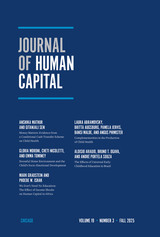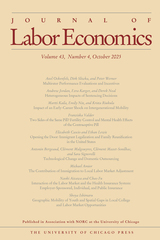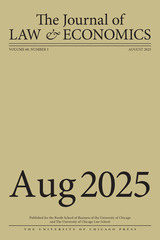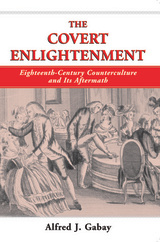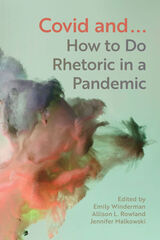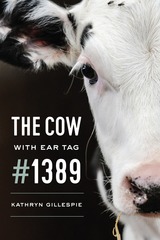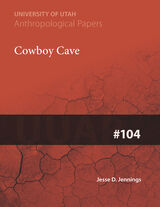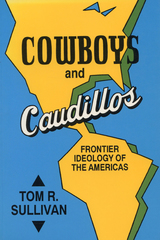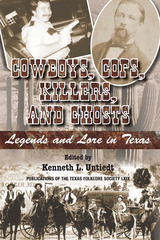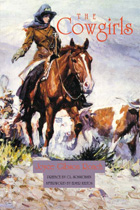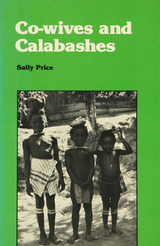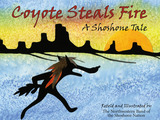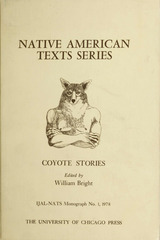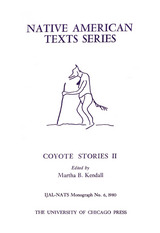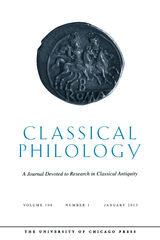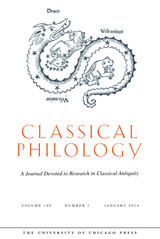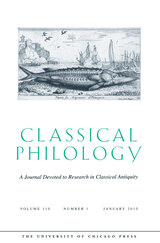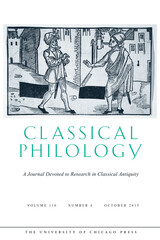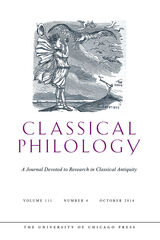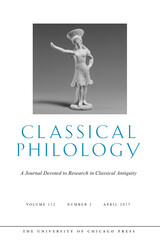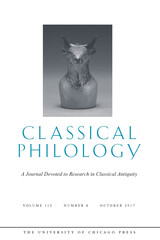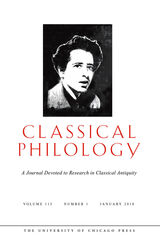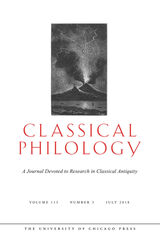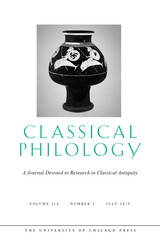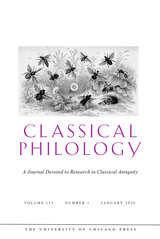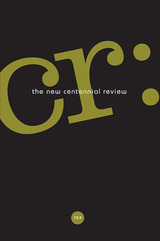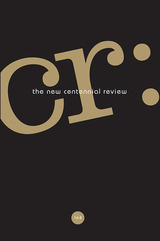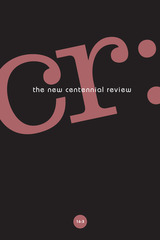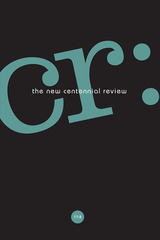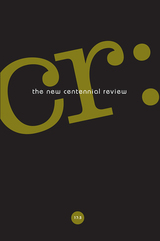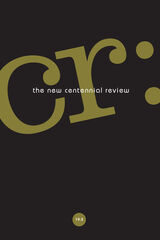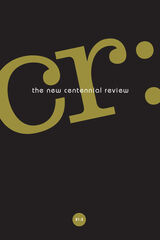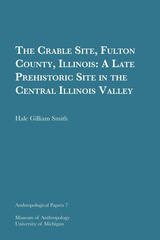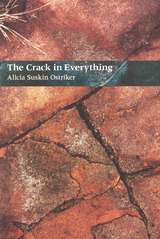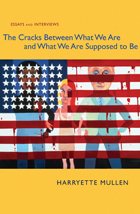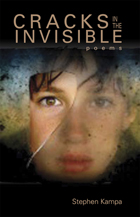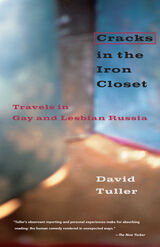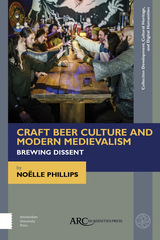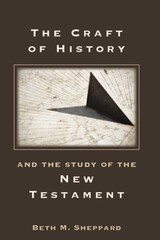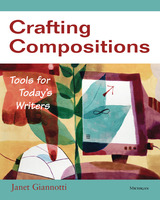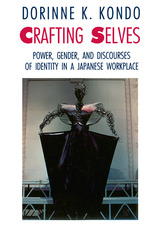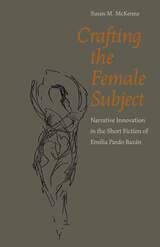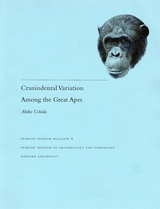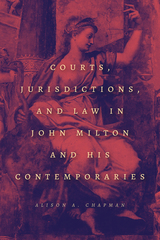 Courts, Jurisdictions, and Law in John Milton and His Contemporaries
Alison A. Chapman
University of Chicago Press, 2020 John Milton is widely known as the poet of liberty and freedom. But his commitment to justice has been often overlooked. As Alison A. Chapman shows, Milton’s many prose works are saturated in legal ways of thinking, and he also actively shifts between citing Roman, common, and ecclesiastical law to best suit his purpose in any given text. This book provides literary scholars with a working knowledge of the multiple, jostling, real-world legal systems in conflict in seventeenth-century England and brings to light Milton’s use of the various legal systems and vocabularies of the time—natural versus positive law, for example—and the differences between them.
Surveying Milton’s early pamphlets, divorce tracts, late political tracts, and major prose works in comparison with the writings and cases of some of Milton’s contemporaries—including George Herbert, John Donne, Ben Jonson, and John Bunyan—Chapman reveals the variety and nuance in Milton’s juridical toolkit and his subtle use of competing legal traditions in pursuit of justice.
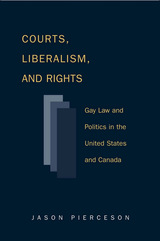 Courts Liberalism And Rights: Gay Law And Politics In The United States and Canada
Jason Pierceson
Temple University Press, 2005 In the courts, the best chance for achieving a broad set of rights for gays and lesbians lies with judges who view liberalism as grounded in an expansion of rights rather than a constraint of government activity.
At a time when most gay and lesbian politics focuses only on the issue of gay marriage, Courts, Liberalism, and Rights guides readers through a nuanced discussion of liberalism, court rulings on sodomy laws and same-sex marriage, and the comparative progress gays and lesbians have made via the courts in Canada.
As debates continue about the ability of courts to affect social change, Jason Pierceson argues that this is possible. He claims that the greatest opportunity for reform via the judiciary exists when a judiciary with broad interpretive powers encounters a political culture that endorses a form of liberalism based on broadly conceived individual rights; not a negative set of rights to be held against the state, but a set of rights that recognizes the inherent dignity and worth of every individual.
 The Courts of International Trade: Judicial Specialization, Expertise, and Bureaucratic Policymaking
Isaac Unah
University of Michigan Press, 1998 In the United States cases involving the interpretation of laws dealing with international trade are heard by a specialized court, the Court of International Trade, and on appeal by a specialized appellate court, the Court of Appeals for the Federal Circuit. In a groundbreaking study, Isaac Unah studies these courts to explore the way specialized courts work and how they fit into the federal court system. We know little about why specialized courts are created and how their role in interpreting law might differ from the role played by the courts of general jurisdiction. These courts play an important role in regulating agencies that affect many aspects of our lives, including the Internal Revenue Service, the Patent Office, and agencies that administer trade laws. The author considers the way these courts relate to the work of the agencies whose cases must always come to these courts. And he offers fresh insights into the differences between specialized courts and courts of general jurisdiction.
This book will be of interest to scholars studying the judiciary, bureaucracies, and international trade law and administration.
Isaac Unah is Assistant Professor of Political Science, University of North Carolina.
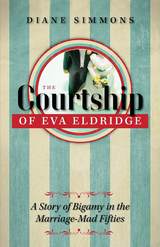 The Courtship of Eva Eldridge: A Story of Bigamy in the Marriage Mad Fifties
Diane Simmons
University of Iowa Press, 2016 Everyone got married in the 1950s, then moved to the suburbs to have the children of the soon-to-be-famous baby boom. For Americans who had survived the Great Depression and World War II, prosperous married life was a triumph. The unwed were objects of pity, scorn, even suspicion. And so in the 1950s, Eva Eldridge, no longer so young and marginally employed, was the perfect target for handsome Vick, who promised everything: storybook romance, marital respectability, and the lively social life she loved. When he disappeared not long after their honeymoon, she was devastated. Eva hadn’t always been so vulnerable. Growing up pretty and popular in rural Oregon, she expected to marry young and live a life much like that of her parents, farming and rearing children. But then the United States threw its weight into World War II and as men headed to battle, the government started recruiting women to work in their places. Eva, like many other young women, found that life in the city with plenty of money, personal freedom, and lots of soldiers and sailors eager to pay court was more exhilarating than life down on the farm. After the war, she was ambivalent about getting married and settling down—at least until Vick arrived. Refusing to believe her brand-new husband had abandoned her, Eva set about tracking down a man who, she now believed, was more damaged by wartime trauma than she had known. But instead of a wounded hero, she found a long string of women much like herself—hard-working, intelligent women who had loved and married Vick and now had no idea where—or even who—he was. Drawing on a trove of some eight hundred letters and papers, Diane Simmons tells the story of Eva’s poignant struggle to get her dream husband back, as well as the stories of the women who had stood at the altar with Vick before and after her. Eva’s remarkable life illuminates women’s struggle for happiness at a time when marriage—and the perfect husband—meant everything.
 Couture and Consensus: Fashion and Politics in Postcolonial Argentina
Regina A. Root
University of Minnesota Press, 2010 Following Argentina’s revolution in 1810, the dress of young patriots inspired a nation and distanced its politics from the relics of Spanish colonialism. Fashion writing often escaped the notice of authorities, allowing authors to masquerade political ideas under the guise of frivolity and entertainment. In Couture and Consensus, Regina A. Root maps this pivotal and overlooked facet of Argentine cultural history, showing how politics emerged from dress to disrupt authoritarian practices and stimulate creativity in a newly independent nation. Drawing from genres as diverse as fiction, poetry, songs, and fashion magazines, Root offers a sartorial history that produces an original understanding of how Argentina forged its identity during the regime of Juan Manuel de Rosas (1829–1852), a critical historical time. Couture and Consensus closely analyzes military uniforms, women’s dress, and the novels of the era to reveal fashion’s role in advancing an agenda and disseminating political goals, notions Root connects to the contemporary moment. An insightful presentation of the discourse of fashion, Couture and Consensus also paints a riveting portrait of Argentine society in the nineteenth century—its politics, people, and creative forces.
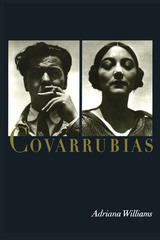 Covarrubias
By Adriana Williams
University of Texas Press, 1994 At the center of an artistic milieu as vital and exciting as the Left Bank of Paris or Greenwich Village, Rosa and Miguel Covarrubias knew almost everyone in the limelight of the 1930s and 1940s—Langston Hughes, Carl Van Vechten, John Huston, Diego Rivera, and Frida Kahlo, to name just a few. As fascinating themselves as any of their friends, the couple together fostered a renaissance of interest in the history and traditional arts of Mexico's indigenous peoples, while amassing an extraordinary collection of art that ranged from pre-Hispanic Olmec and Aztec sculptures to the work of Diego Rivera. Written by a long-time friend of Rosa, this book presents a sparkling account of the life and times of Rosa and Miguel. Adriana Williams begins with Miguel's birth in 1904 and follows the brilliant early flowering of his artistic career as a renowned caricaturist for Vanity Fair and the New Yorker magazines, his meeting and marriage with Rosa at the height of her New York dancing career, and their many years of professional collaboration on projects ranging from dance to anthropology to painting and art collecting to the development of museums to preserve Mexico's pre-Columbian heritage. Interviewing as many of their friends as possible, Williams fills her narrative with reminiscences that illuminate Miguel's multifaceted talents, Rosa's crucial collaboration in many of his projects, and their often tempestuous relationship.
 Covenant
Alan Shapiro
University of Chicago Press, 1991 "The coherence Shapiro prizes is both more thorough and more thoroughgoing than that offered by a moralizing intelligence. His poetry comes by its sad wisdom through its accomodations to human happenstance and estrangement. . . .In Covenant, sympathy grounds itself in worldly particulars, and subjectivity begets responsibilities. Hardnosed yet tenderly attentive, Shapiro's acute self-consciousness distills an exacting conscientiousness."—David Barber, Poetry
"At forty-years-old and already the author of four superbly written books of poems, Shapiro has produced a work of such authority and originality that he has permanently enlarged my hopes and expectations for contemporary poetry. His risk-loving swiftness of perception and his affinity for stories that up-end convention and taboo have enabled him to reclaim, for poets of my generation, areas of feeling and linguistic virtuosity that originated with William Carlos Williams, Elizabeth Bishop, J. V. Cunningham, and Ivor Winters. It is hard for me to see how an ideal anthologist of the future will be able to include their names without gratefully including his."—Tom Sleigh, Boston Phoenix
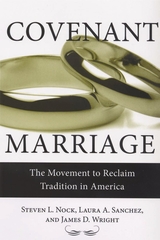 Covenant Marriage: The Movement to Reclaim Tradition in America
Nock, Steven
Rutgers University Press, 2008 Regardless how you interpret the statistics, the divorce rate in the United States is staggering. But, what if the government could change this? Would families be better off if new public policies made it more difficult for couples to separate?
This book explores a movement that emerged over the past fifteen years, which aims to do just that. Guided by certain politicians and religious leaders who herald marriage as a solution to a range of longstanding social problems, a handful of state governments enacted "covenant marriage" laws, which require couples to choose between a conventional and a covenant marriage. While the familiar type of union requires little effort to enter and can be terminated by either party unilaterally, covenant marriage requires premarital counseling, an agreement bound by fault-based rules or lengthy waiting periods to exit, and a legal stipulation that divorce can be granted only after the couple has received counseling.
Drawing on interviews with over 700 couples-half of whom have chosen covenant unions-this book not only evaluates the viability of public policy in the intimate affairs of marriage, it also explores how growing public discourse is causing men and women to rethink the meaning of marriage.
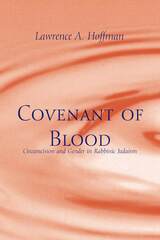 Covenant of Blood: Circumcision and Gender in Rabbinic Judaism
Lawrence A. Hoffman
University of Chicago Press, 1995 Central to both biblical narrative and rabbinic commentary, circumcision has remained a defining rite of Jewish identity, a symbol so powerful that challenges to it have always been considered taboo. Lawrence Hoffman seeks to find out why circumcision holds such an important place in the Jewish psyche. He traces the symbolism of circumcision through Jewish history, examining its evolution as a symbol of the covenant in the post-exilic period of the Bible and its subsequent meaning in the formative era of Mishnah and Talmud.
In the rabbinic system, Hoffman argues, circumcision was neither a birth ritual nor the beginning of the human life cycle, but a rite of covenantal initiation into a male "life line." Although the evolution of the rite was shaped by rabbinic debates with early Christianity, the Rabbis shared with the church a view of blood as providing salvation. Hoffman examines the particular significance of circumcision blood, which, in addition to its salvific role, contrasted with menstrual blood to symbolize the gender dichotomy within the rabbinic system. His analysis of the Rabbis' views of circumcision and menstrual blood sheds light on the marginalization of women in rabbinic law. Differentiating official mores about gender from actual practice, Hoffman surveys women's spirituality within rabbinic society and examines the roles mothers played in their sons' circumcisions until the medieval period, when they were finally excluded.
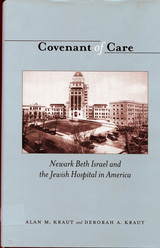 Covenant of Care: Newark Beth Israel and the Jewish Hospital in America
Kraut, Alan M
Rutgers University Press, 2006 Winner of the 2008 Author's Award from the New Jersey Studies Academic Alliance
Where were you born? Were you born at the Beth? Many thousands of Americans-Jewish and non-Jewish-were born at a hospital bearing the Star of David and named Beth Israel, Mount Sinai, or Montefiore. In the United States, health care has been bound closely to the religious impulse. Newark Beth Israel Hospital is a distinguished modern medical institution in New Jersey whose history opens a window on American health care, the immigrant experience, and urban life. Alan M. and Deborah A. Kraut tell the story of this important institution, illuminating the broader history of voluntary nonprofit hospitals created under religious auspices initially to serve poor immigrant communities. Like so many Jewish hospitals in the early half of the twentieth century, "the Beth" cared not only for its own community's poor and underprivileged, a responsibility grounded in the Jewish traditions of tzedakah ("justice") and tikkun olam ("to heal the world"), but for all Newarkers.
Since it first opened its doors in 1902, the Beth has been an engine of social change. Jewish women activists and immigrant physicians founded an institution with a nonsectarian admissions policy and a welcome mat for physicians and nurses seeking opportunity denied them by anti-Semitism elsewhere. Research, too, flourished at the Beth. Here dedicated medical detectives did path-breaking research on the Rh blood factor and pacemaker development. When economic shortfalls and the Great Depression threatened the Beth's existence, philanthropic contributions from prominent Newark Jews such as Louis Bamberger and Felix Fuld, the efforts of women volunteers, and, later, income from well-insured patients saved the institution that had become the pride of the Jewish community.
The Krauts tell the Beth Israel story against the backdrop of twentieth-century medical progress, Newark's tumultuous history, and the broader social and demographic changes altering the landscape of American cities. Today, the United States, in the midst of another great wave of immigration, once again faces the question of how to provide newcomers with culturally sensitive and economically accessible medical care. Covenant of Care will inform and inspire all those working to meet these demands, offering a compelling look at the creative ways that voluntary hospitals navigated similar challenges throughout the twentieth century.
 Covenant of Justice: Prayers, Poems, and Meditations from Women of Reform Judaism
Women of Reform Judaism
Central Conference of American Rabbis, 2025 Covenant of Justice is a dynamic collection of prayers, poems, and reflections on the most pressing social justice issues of our time, viewed through the lens of Jewish tradition and covenant. Written by a diverse group of female, nonbinary, and genderfluid contributors, the pieces address key topics including racial equity, climate justice, gender equality, and reproductive rights. With a focus on action rooted in the Jewish value of tikkun olam (repairing the world), this book serves as both an educational resource and a call to action. Practical insights, historical context, and modern interpretations of Jewish texts make this an essential guide for individuals and communities striving to effect positive change. Covenant of Justice is an accessible, inspiring resource and call to action for readers from all walks of life seeking to build a more just world.
Copublished with Women of Reform Judaism
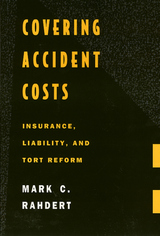 Covering Accident Costs: Insurance, Liability, and Tort Reforms
Mark C. Rahdert
Temple University Press, 1995 Over the past century, tort law and insurance have developed deeply intertwined legal and economic roots. Insurance usually determines whether tort cases are brought to trial, whom plaintiffs sue, how much they claim, who provides the defense, how the case gets litigated, the dynamics of the settlement, and how much plaintiffs ultimately recover. But to what extent should liability rules be influenced by insurance? In this study, Mark Rahdert identifies the leading arguments both in favor of and against what he terms the "insurance rationale"—the idea that tort law should be structured to facilitate victim access to assured compensation. The insurance rationale has been a leading force in the development of product liability law and, as a component of accident compensation, has significantly influenced pro-plaintiff advances in principal areas of tort law. However, the insurance rationale is also the source of great controversy. Critics charge that liability rules deliberately set to maximize plaintiffs' access to insurance funds have corrupted the system, causing insurance costs to spiral upward uncontrollably. Considering the strengths and weaknesses of both sides of the current debate, Rahdert develops a modified version of the insurance rationale that can become a tool for evaluating future tort reform proposals.
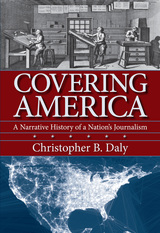 Covering America: A Narrative History of a Nation's Journalism
Christopher B. Daly
University of Massachusetts Press, 2018 Journalism is in crisis, with traditional sources of news under siege, a sputtering business model, a resurgence of partisanship, and a persistent expectation that information should be free. In Covering America, Christopher B. Daly places the current crisis within historical context, showing how it is only the latest challenge for journalists to overcome.
In this revised and expanded edition, Daly updates his narrative with new stories about legacy media like the New York Times and the Washington Post, and the digital natives like the Huffington Post and Buzzfeed. A new final chapter extends the study of the business crisis facing journalism by examining the "platform revolution" in media, showing how Facebook, Twitter, and other social media are disrupting the traditional systems of delivering journalism to the public. In an era when the factual basis of news is contested and when the government calls journalists "the enemy of the American people" or "the opposition party," Covering America brings history to bear on the vital issues of our times.
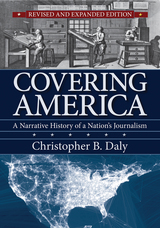 Covering America: A Narrative History of a Nation's Journalism
Christopher B. Daly
University of Massachusetts Press, 2018 Journalism is in crisis, with traditional sources of news under siege, a sputtering business model, a resurgence of partisanship, and a persistent expectation that information should be free. In Covering America, Christopher B. Daly places the current crisis within historical context, showing how it is only the latest challenge for journalists to overcome.
In this revised and expanded edition, Daly updates his narrative with new stories about legacy media like the New York Times and the Washington Post, and the digital natives like the Huffington Post and Buzzfeed. A new final chapter extends the study of the business crisis facing journalism by examining the "platform revolution" in media, showing how Facebook, Twitter, and other social media are disrupting the traditional systems of delivering journalism to the public. In an era when the factual basis of news is contested and when the government calls journalists "the enemy of the American people" or "the opposition party," Covering America brings history to bear on the vital issues of our times.
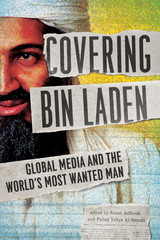 Covering Bin Laden: Global Media and the World's Most Wanted Man
Edited by Susan Jeffords and Fahed Yahya Al-Sumait
University of Illinois Press, 2015 Starting in 2001, much of the world media used the image of Osama bin Laden as a shorthand for terrorism. Bin Laden himself considered media manipulation on a par with military, political, and ideological tools, and intentionally used interviews, taped speeches, and distributed statements to further al-Qaida's ends.
In Covering Bin Laden, editors Susan Jeffords and Fahed Yahya Al-Sumait collect perspectives from global scholars exploring a startling premise: that media depictions of Bin Laden not only diverge but often contradict each other, depending on the media provider and format, the place in which the depiction is presented, and the viewer's political and cultural background. The contributors analyze the representations of the many Bin Ladens, ranging from Al Jazeera broadcasts to video games. They examine the media's dominant role in shaping our understanding of terrorists and why/how they should be feared, and they engage with the ways the mosaic of Bin Laden images and narratives have influenced policies and actions around the world.
Contributors include Fahed Al-Sumait, Saranaz Barforoush, Aditi Bhatia, Purnima Bose, Ryan Croken, Simon Ferrari, Andrew Hill, Richard Jackson, Susan Jeffords, Joanna Margueritte-Giecewicz, Noha Mellor, Susan Moeller, Brigitte Nacos, Courtney C. Radsch, and Alexander Spencer.
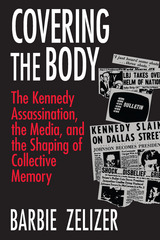 Covering the Body: The Kennedy Assassination, the Media, and the Shaping of Collective Memory
Barbie Zelizer
University of Chicago Press, 1992 Images of the assassination of John F. Kennedy are burned deeply into the memories of millions who watched the events of November 1963 unfold live on television. Never before had America seen an event of this magnitude as it happened. But what is it we remember? How did the near chaos of the shooting and its aftermath get transformed into a seamless story of epic proportions? In this book, Barbie Zelizer explores the way we learned about and came to make sense of the killing of the president.
Covering the Body (the title refers to the charge given journalists to follow a president) is a powerful reassessment of the media's role in shaping our collective memory of the assassination—at the same time as it used the assassination coverage to legitimize its own role as official interpreter of American reality. Of the more than fifty reporters covering Kennedy in Dallas, no one actually saw the assassination. And faced with a monumentally important story that was continuously breaking, most journalists had no time to verify leads or substantiate reports. Rather, they took discrete moments of their stories and turned them into one coherent narrative, blurring what was and was not "professional" about their coverage.
Through incisive analyses of the many accounts and investigations in the years since the shooting, Zelizer reveals how journalists used the assassination not just to relay the news but to address the issues they saw as central to the profession and to promote themselves as cultural authorities. Indeed, argues Zelizer, these motivations are still alive and are at the core of the controversy surrounding Oliver Stone's movie, JFK.
At its heart, Covering the Body raises serious questions about the role of the media in defining our reality, and shaping our myths and memories. In tracing how journalists attempted to answer questions that still trouble most Americans, Zelizer offers a fascinating analysis of the role of the media as cultural authorities.
THE COVERT ENLIGHTENMENT: EIGHTEENTH-CENTURY COUNTERCULTURE & ITS AFTERMATH
ALFRED J. GABAY
Swedenborg Foundation Publishers, 2005
The European Enlightenment in the latter half of the eighteenth century heralded a grave conflict between theological and scientific modes of thought, starkly revealing the ancient tensions between spiritual knowledge and rationalism. Yet there was another, lesser-known movement during this time---a "covert" Enlightenment---that sought to bring fresh perspectives on the soul, and by extension, on the human mind and on consciousness. This work examines the influence of Emanuel Swedenborg and Anton Mesmer on the budding movement toward psychology in the late-eighteenth century and also spiritualism and millennialism in the nineteenth century.
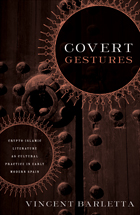 Covert Gestures: Crypto-Islamic Literature as Cultural Practice in Early Modern Spain
Vincent Barletta
University of Minnesota Press, 2005 Forcibly expelled from Spain in the early seventeenth century, the substantial Muslim community known as the moriscos left behind them a hidden yet extremely rich corpus of manuscripts. Copied out in Arabic script and concealed in walls, false floors, and remote caves, these little-known texts now offer modern readers an absorbing look into the cultural life of the moriscos during the hundred years between their forced conversion to Christianity and their eventual expulsion. Covert Gestures reveals how the traditional Islamic narratives of the moriscos both shaped and encoded a wide range of covert social activity characterized by a profound and persistent concern with time and temporality. Using a unique blend of literary analysis, linguistic anthropology, and phenomenological philosophy, Barletta explores the narratives as testimonials of past human experiences and discovers in them evidence of community resistance. In its interdisciplinary approach, Vincent Barletta's work is nothing less than a rewriting of the cultural history of Muslim Spain, as well as a replotting of the future course of medieval and early modern literary studies.
 The Covert Life of Hospital Architecture
Edited by Julie Zook and Kerstin Sailer
University College London, 2022 A strong visual text that makes research on hospital architecture comprehensible.
This book addresses hospital architecture as a set of interlocked, overlapping spatial and social conditions, identifying ways that hospital spaces work to produce desired outcomes such as greater patient safety, increased care provider communication, and more intelligible corridors.
The volume brings together emerging research on hospital environments. Opening with a description of hospital architecture that emphasizes everyday relations, the book examines the patient room and its intervisibility with adjacent spaces, care teams and on-ward support for their work, and the intelligibility of public circulation spaces for visitors. The final chapter moves outside the hospital to describe the current healthcare crisis of the global pandemic. Reflective essays by practicing designers follow each chapter, bringing perspectives from professional practice into the discussion.
This volume provides new insights into how to better design hospitals through principles that have been tested empirically. It will become a reference for healthcare planners, designers, architects, and administrators, as well as for readers from sociology, psychology, and other areas of the social sciences.
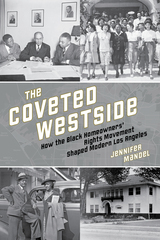 The Coveted Westside: How the Black Homeowners' Rights Movement Shaped Modern Los Angeles
Jennifer Mandel
University of Nevada Press, 2022 From the middle of the nineteenth century, as Euro-Americans moved westward, they carried with them long-held prejudices against people of color. By the time they reached the West Coast, their new settlements included African Americans and recent Asian immigrants, as well as the indigenous inhabitants and descendants of earlier Spanish and Mexican settlers. The Coveted Westside deals with the settlement and development of Los Angeles in the context of its multiracial, multiethnic population, especially African Americans.
Mandel exposes the enduring struggle between Whites determined to establish their hegemony and create residential heterogeneity in the growing city, and people of color equally determined to obtain full access to the city and the opportunities, including residential, that it offered. Not only does this book document the Black homeowners’ fight against housing discrimination, it shares personal accounts of Blacks’ efforts to settle in the highly desirable Westside of Los Angeles. Mandel explores the White-derived social and legal mechanisms that created this segregated city and the African American-led movement that challenged efforts to block access to fair housing.
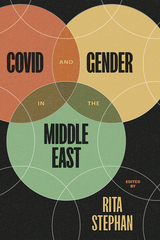 COVID and Gender in the Middle East
Edited by Rita Stephan
University of Texas Press, 2023 As the coronavirus ravages the globe, its aftermaths have brought gender inequalities to the forefront of many conversations. Countries in the Middle East and North Africa have been slow to prepare for, adapt to, and mitigate the COVID-19 health crisis and its impacts on governance, economics, security, and rights. Women’s physical well-being, social safety nets, and economic participation have been disproportionately affected, and with widespread shutdowns and capricious social welfare programs, women are exiting the workplace and the classroom, carrying the caregiving burden. With feminist foregrounding, Rita Stephan's collection COVID and Gender in the Middle East gathers an impressive group of local scholars, activists, and policy experts. The book examines a range of national and localized responses to gender-specific issues around COVID’s health impact and the economic fallout and resulting social vulnerabilities, including the magnified marginalization of Syrian refugees; the inequitable treatment of migrant workers in Bahrain; and the inadequate implementation of gender-based violence legislation in Morocco. An essential global resource, this book is the first to provide empirical evidence of COVID’s gendered effects.
COVID and...: How to Do Rhetoric in a Pandemic
Emily Winderman
Michigan State University Press, 2023 Covid and . . . How To Do Rhetoric in a Pandemic is among the first edited collections to consider how rhetoric shapes Covid’s disease trajectory. Arguing that the circulation of any virus must be understood in tandem with the public communication accompanying it, this collection converses with interdisciplinary stakeholders also committed to the project of social wellness during pandemic times. With inventive ways of thinking about structural inequities in health, these essays showcase the forces that pandemic rhetoric exerts across health conditions, politics, and histories of social injustice.
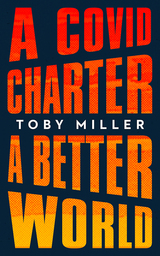 A COVID Charter, A Better World
Toby Miller
Rutgers University Press, 2021 With unprecedented speed, scientists have raced to develop vaccines to bring the COVID-19 pandemic under control and restore a sense of normalcy to our lives. Despite the havoc and disruption the pandemic has caused, it’s exposed exactly why we should not return to life as we once knew it. Our current profit-driven healthcare systems have exacerbated global inequality and endangered public health, and we must take this opportunity to construct a new social order that understands public health as a basic human right.
A COVID Charter, A Better World outlines the steps needed to reform public policies and fix the structural vulnerabilities that the current pandemic has made so painfully clear. Leading scholar Toby Miller argues that we must resist neoliberalism’s tendency to view health in terms of individual choices and market-driven solutions, because that fails to preserve human rights. He addresses the imbalance of geopolitical power to explain how we arrived at this point and shows that the pandemic is more than just a virus—it’s a social disease. By examining how the U.S., Britain, Mexico, and Colombia have responded to the COVID-19 crisis, Miller investigates corporate, scientific, and governmental decision-making and the effects those decisions have had on disadvantaged local communities. Drawing from human rights charters ratified by various international organizations, he then proposes a COVID charter, calling for a new world that places human lives above corporate profits.
 COVID Diagnosed the System
Bridget Conley
Rutgers University Press The American criminal justice system was in flux in 2020, a clash of possibilities for reform, retrenchment, and radical change – nowhere more so than in Massachusetts, which had just passed major criminal justice reform. The COVID-19 pandemic interrupted the moment with life-threatening force, ravaging people held in prisons and jails across the country. However, it did not so much create new deprivations and suffering, as it exposed prisons as sites of physical, institutional, and psychological violence that do not make communities safer. At the same time, advocates for people in prisons – including many incarcerated and formerly incarcerated people – seized on the pandemic’s disruptions to demand change. Detailing the first year of the pandemic inside the Massachusetts state prison system, this book argues that the history of the pandemic inside prisons exposed both the cruelties of incarceration and the power of change when it is led by directly affected people.
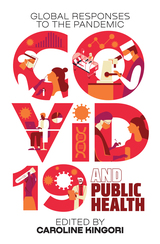 COVID-19 and Public Health: Global Responses to the Pandemic
Caroline Kingori
Ohio University Press, 2024 This book contributes to the discourse on public health and COVID-19 prevention in three ways. First, by examining COVID-19’s impact on underserved and resource-limited communities, it addresses a continuing challenge in public health to ensure equitable access to adequate health care services. Contextually relevant initiatives must recognize and overcome injustices, stigma, racism, and discrimination in order to support the public health system. Second, the book argues that despite policies in high-income countries that led to the development and authorization of life-saving vaccines, attempts to curtail further transmission globally are futile without a concerted effort to ensure equal distribution of those vaccines. Third, it assesses the environmental impact of medical waste generated by COVID-19 as an emerging issue, one that cannot be glossed over with short-term solutions. Strategies to address medical waste like sanitizers, masks, gloves, and other products must be included in national policy to protect the populace and first responders. Utilizing a retrospective lens and examining lessons learned at the end of each chapter, COVID-19 and Public Health discusses global health success with other pandemics, risk communication, community engagement, interplay of policy and politics, environmental health influence, and public health practice implications. The book is suitable as an introductory text in public health or other related courses, such as environmental health, health policy, global health, health disparities, cross-cultural issues, community engagement, or health behavior. Contributors: Vashti Adams, Obasanjo Afolabi Bolarinwa, Adanna Agbo, Kobi V. Ajayi, Adaeze Aroh, Ugonwa Aroh, Timnit Berhane, Emma Biegacki, Claire Chaumont, Jaih Craddock, Marquitta Dorsey, Ghanem Elhersh, Kristen Garcia, Whitney Garney, Jessica Gokee LaRose, Jeffrey Glenn, F. Todd Gray, Rudene Haynes, Robert Heimer, Tamsim Hoque, Iman Ikram, Laeeq Khan, Kujang Laki, Rachel Ludeke, Devin Madden, Tyra Montour, Kenneth Morford, Michele Morrone, Maghboeba Mosavel, Carolyn Nganga-Good, Jerry Okal, Aggrey Willis Otieno, Sonya Panjwani, Elizabeth Prom-Wormley, Tremayne Robertson, Katie Schenk, Grace Sikapokoo, Vanessa Sheppard, Arnethea L. Sutton, Maria Thomson, Katherine Y. Tossas, Nita Vangeepuram, Pablo Villalobos Dintrans, Elizabeth Wachira, Robert A Winn, Rafeek Yusuf, Zenab Yusuf
 The COVID-19 Intelligence Failure: Why Warning Was Not Enough
Erik J. Dahl
Georgetown University Press, 2023 An in-depth analysis of why COVID-19 warnings failed and how to avert the next disaster Epidemiologists and national security agencies warned for years about the potential for a deadly pandemic, but in the end global surveillance and warning systems were not enough to avert the COVID-19 disaster. In The COVID-19 Intelligence Failure, Erik J. Dahl demonstrates that understanding how intelligence warnings work—and how they fail—shows why the years of predictions were not enough. In the first in-depth analysis of the topic, Dahl examines the roles that both traditional intelligence services and medical intelligence and surveillance systems play in providing advance warning against public health threats—and how these systems must be improved for the future. For intelligence to effectively mitigate threats, specific, tactical-level warnings must be collected and shared in real time with receptive decision makers who will take appropriate action. Dahl shows how a combination of late and insufficient warnings about COVID-19, the Trump administration’s political aversion to scientific advice, and decentralized public health systems all exacerbated the pandemic in the United States. Dahl’s analysis draws parallels to other warning failures that preceded major catastrophes from Pearl Harbor to 9/11, placing current events in context. The COVID-19 Intelligence Failure is a wake-up call for the United States and the international community to improve their national security, medical, and public health intelligence systems and capabilities.
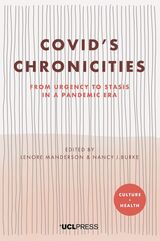 Covid’s Chronicities: From Urgency to Stasis in a Pandemic Era
Edited by Lenore Manderson and Nancy J. Burke
University College London, 2025 Ponders how the pandemic didn’t just disrupt the world—it deepened existing fractures and forced communities to navigate an unpredictable new normal.
While the initial urgency of the COVID-19 pandemic fades, its long-term disruptions continue to reshape societies and individual lives. Covid’s Chronicities captures the global experience of a crisis that has evolved into a persistent state of uncertainty. Based on research from Europe, the Americas, Asia, and Africa, this volume examines how governments and communities have navigated everything from shifting policies to the social and economic aftershocks of the pandemic.
This volume reveals how COVID-19 has exacerbated existing inequalities and exposed deep structural neglect while also highlighting the resilience of communities, such as Indigenous knowledge systems and grassroots mutual aid networks. Tracing the pandemic’s transition from emergency to enduring crisis, the authors offer a sobering yet hopeful analysis of how people continue to remake their worlds in the face of ongoing instability.
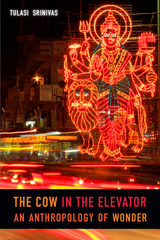 The Cow in the Elevator: An Anthropology of Wonder
Tulasi Srinivas
Duke University Press, 2018 In The Cow in the Elevator Tulasi Srinivas explores a wonderful world where deities jump fences and priests ride in helicopters to present a joyful, imaginative, yet critical reading of modern religious life. Drawing on nearly two decades of fieldwork with priests, residents, and devotees, and her own experience of living in the high-tech city of Bangalore, Srinivas finds moments where ritual enmeshes with global modernity to create wonder—a feeling of amazement at being overcome by the unexpected and sublime. Offering a nuanced account of how the ruptures of modernity can be made normal, enrapturing, and even comical in a city swept up in globalization's tumult, Srinivas brings the visceral richness of wonder—apparent in creative ritual in and around Hindu temples—into the anthropological gaze. Broaching provocative philosophical themes like desire, complicity, loss, time, money, technology, and the imagination, Srinivas pursues an interrogation of wonder and the adventure of writing true to its experience. The Cow in the Elevator rethinks the study of ritual while reshaping our appreciation of wonder's transformative potential for scholarship and for life.
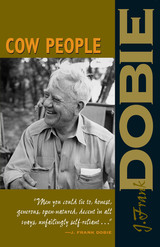 Cow People
By J. Frank Dobie
University of Texas Press, 1981 Cow People records the fading memories of a bygone Texas, the reminiscences of the cow people themselves. These are the Texans of the don't-fence-me-in era, their faces pinched by years of squinting into the desert glare, tanned by the sun and coarsened by the dust of the Chisholm Trail. Their stories are often raucous but just as often quiet as hot plains under a pale Texan sky. A native Texan, J. Frank Dobie had an inborn knowledge of the men and customs of the trail camps. Cattlemen were as various as the country was big. Ab Blocker was a tall, quiet man who belonged totally to the cattle and the silent plains. But big men often had big lungs. "Shanghai Pierce was the loudest man in the country. He would sit at one end of a day coach and in normal voice hold conversation with some man at the other end of the coach, who of course had to yell, while the train was clanking along. He knew everybody, yelled at everybody he saw." Texas bred tall men and taller stories. There was Findlay Simpson, who played havoc with fact but whiled away the drivers' long, lonely evenings with his tales. Old Findlay told of a country so wet that it bogged down the shadow of a buzzard, and of cattle that went into hibernation during rugged winters; he once spun yarns for three days straight, outlasting his listeners in a marathon of endurance. All real cow people—from the cattle drivers to the cattle owners—lived by a simple code based on the individual's integrity. Bothering anyone else's poke or business uninvited was strictly forbidden, and enforcement of this unwritten law was as easy as pulling a trigger. Honesty was taken for granted, and a cowman's name on a check made it negotiable currency. Yet Texas had its "bad guys"—the crooks, the thieves, even the tightwads. "A world big enough to hold a rattlesnake and a purty woman is big enough for all kinds of people," wrote Dobie. This is the world whose vast and various population the reader will find in Cow People.
The Cow with Ear Tag #1389
Kathryn Gillespie
University of Chicago Press, 2018 To translate the journey from a living cow to a glass of milk into tangible terms, Kathryn Gillespie set out to follow the moments in the life cycles of individual animals—animals like the cow with ear tag #1389. She explores how the seemingly benign practice of raising animals for milk is just one link in a chain that affects livestock across the agricultural spectrum. Gillespie takes readers to farms, auction yards, slaughterhouses, and even rendering plants to show how living cows become food. The result is an empathetic look at cows and our relationship with them, one that makes both their lives and their suffering real.
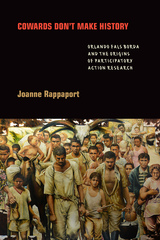 Cowards Don't Make History: Orlando Fals Borda and the Origins of Participatory Action Research
Joanne Rappaport
Duke University Press, 2020 In the early 1970s, a group of Colombian intellectuals led by the pioneering sociologist Orlando Fals Borda created a research-activist collective called La Rosca de Investigación y Acción Social (Circle of Research and Social Action). Combining sociological and historical research with a firm commitment to grassroots social movements, Fals Borda and his colleagues collaborated with indigenous and peasant organizations throughout Colombia. In Cowards Don’t Make History Joanne Rappaport examines the development of participatory action research on the Caribbean coast, highlighting Fals Borda’s rejection of traditional positivist research frameworks in favor of sharing his own authority as a researcher with peasant activists. Fals Borda and his colleagues inserted themselves as researcher-activists into the activities of the National Association of Peasant Users, coordinated research priorities with its leaders, studied the history of peasant struggles, and, in collaboration with peasant researchers, prepared accessible materials for an organizational readership, thereby transforming research into a political organizing tool. Rappaport shows how the fundamental concepts of participatory action research as they were framed by Fals Borda continue to be relevant to engaged social scientists and other researchers in Latin America and beyond.
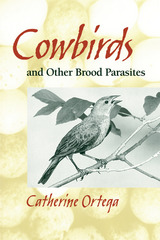 Cowbirds and Other Brood Parasites
Catherine P. Ortega
University of Arizona Press, 1998 The Brown-headed Cowbird is known to use the nests of more than 200 other bird species, and cowbirds in general are believed to play a role in the decline of some migratory songbird populations. These brood parasites—birds that lay their eggs in the nests of others—have long flourished in North America.
In this timely book, Catherine Ortega summarizes and synthesizes a wealth of information on cowbirds from around the world that has appeared since the publication of Herbert Friedmann's classic 1929 monograph on these birds. Most of this information has appeared in the last quarter-century and reflects advances in our understanding of how brood parasitism influences, and is influenced by, host species. Ortega shows that in order to manage cowbirds without further damaging delicate balances in host-parasite relationships, it is necessary to understand such factors as behavior, reproduction, population dynamics, and response to landscape patterns. She examines and explains the origin, evolution, and costs of brood parasitism, and she discusses the philosophical and ecological considerations regarding the management of cowbirds—a controversial issue because of their perceived influence on threatened and endangered birds.
Because brood parasitism has evolved independently in various bird families, information on this adaptive strategy is of great ecological interest and considerable value to wildlife management. Cowbirds and Other Brood Parasites is an important reference on these creatures that enhances our understanding of both their behavior and their part in the natural world.
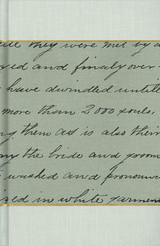 Cowboy Apostle: The Diaries of Anthony W. Ivins, 1875-1932
Anthony W. Ivins
Signature Books, 2013
Anthony W. Ivins (1852-1934) migrated to St. George, Utah, at age nine where he later became an influential civic and ecclesiastical leader. He married Elizabeth A. Snow, daughter of apostle Erastus F. Snow. Ivins was a first cousin of Heber J. Grant, and served as his counselor while Grant was LDS president. Ivins filled several Mormon missions to Mexico and presided as the Juarez, Mexico stake president where he performed post-manifesto marriages. He was appointed by the U.S. government as an Indian agent, and was warmly acquainted with Porfirio Diaz, president of Mexico. Involved in politics in St. George, Ivins held aspirations of running as a Democrat for governor of Utah. In 1907, he was ordained an apostle and later advanced to the First Presidency. Tone, as he called himself, was an accomplished horseman who worked with, and invested in, livestock. He was a game-hunting cowboy who became a statesman for both his country and his expanding religious community.
Though in his correspondence Ivins expressed paramount concern for members of his family, he rarely mentions them in his journals. Rather, his diaries chronicle his business and religious observations including meetings with the Quorum of the Twelve and others. He records meetings of the apostles where decisions were made to remove Church leaders from office who had entered into polygamy after 1904, and details the Church’s dealings with the Mexican government to safeguard the Mormon colonists. There are also discussions where doctrinal principles were clarified. For example, in 1912, Ivins reported that President Joseph F. Smith addressed Brigham Young’s Adam God teachings and affirmed that it was “not a doctrine of the Church.” Ivins clearly loved the ruggedness of outdoor life, as evidenced in his passion for hunting, but was also intrigued with the curiosities at the Utah State Fair, the entertaining showmanship of Buffalo Bill, and the refinement of the theater. Tragedy became commonplace as he recorded vigilante-like justice against Indians and Mexicans who were killed for stealing food, and witnessing the execution of John D. Lee, a once favored son of Mormonism. Appendices of Cowboy Apostle include Ivins Record Book of Marriage and an essay by Ivins son, H. Grant Ivins titled “Polygamy in Mexico as Practiced by the Mormon Church, 1895-1905.”
Cowboy Cave: UUAP 104
Jesse D. Jennings
University of Utah Press, 1980 This descriptive report on the 1975 archaeological excavations at Cowboy Cave, an Archaic site located in Wayne County, Utah, provides relevant comparative and interpretive comments by a number of authors.
Cowboy Hero & Its Audience: Popular Culture As Market Derived Art
Alf H. Walle
University of Wisconsin Press, 2000 Elements of popular culture, such as literature and films, are major industries. If scholars are to fully understand how popular culture evolves and functions, techniques for dealing with the impact of business need to be factored into the analysis.
Using the history of the cowboy story from 1820 to 1970 as an extended example, Alf H. Walle combines popular culture scholarship with marketing theory to provide a hybrid analysis. Wall examines major authors and genres of Western American literature and film; he also explores why certain respected authors were unable to significantly impact the cowboy story even though their innovations were embraced by later generations. Finally Wall provides a hybrid analysis combining business and popular culture theory in an overarching analysis.
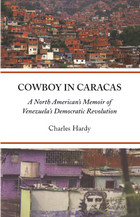 Cowboy in Caracas: A North American's Memoir of Venezuela's Democratic Revolution
Charles Hardy
Northwestern University Press, 2007 No president today is more controversial than Venezuela's Hugo Chávez Frías. Elected in a landslide in 1998, he promised a peaceful revolution. That peaceful dream became a nightmare when Chávez was overthrown in a coup d'état in 2002. Surprisingly, he was brought back to power by his supporters, mostly barrio dwellers, within forty-eight hours. Although Chávez continues to be dogged by controversy, he stays in power because of these supporters who see themselves as active participants in a democratic revolution. As a former Catholic priest who has lived in Venezuela for the past twenty years and spent eight of those years in a cardboard-and-tin shack in one of Caracas' barrios, Charles Hardy is in a unique position to explain what is taking place. Cowboy in Caracas: A North American's Memoir of Venezuela's Democratic Revolution gives the reader insight into the Venezuelan reality, using an anecdotal presentation drawn from the writer's personal experiences.
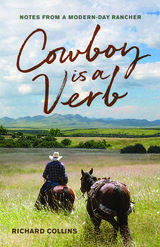 Cowboy is a Verb: Notes from a Modern-day Rancher
Richard Collins
University of Nevada Press, 2019 From the big picture to the smallest detail, Richard Collins fashions a rousing memoir about the modern-day lives of cowboys and ranchers. However, Cowboy is a Verb is much more than wild horse rides and cattle chases. While Collins recounts stories of quirky ranch horses, cranky cow critters, cow dogs, and the people who use and care for them, he also paints a rural West struggling to survive the onslaught of relentless suburbanization.
A born storyteller with a flair for words, Collins breathes life into the geology, history, and interdependency of land, water, and native and introduced plants and animals. He conjures indelible portraits of the hardworking, dedicated people he comes to know. With both humor and humility, he recounts the day-to-day challenges of ranch life such as how to build a productive herd, distribute your cattle evenly across a rough and rocky landscape, and establish a grazing system that allows pastures enough time to recover. He also intimately recounts a battle over the endangered Gila topminnow and how he and his neighbors worked with university range scientists, forest service conservationists, and funding agencies to improve their ranches as well as the ecological health of the Redrock Canyon watershed.
Ranchers who want to stay in the game don’t dominate the landscape; instead, they have to continually study the land and the animals it supports. Collins is a keen observer of both. He demonstrates that patience, resilience, and a common-sense approach to conservation and range management are what counts, combined with an enduring affection for nature, its animals, and the land. Cowboy is a Verb is not a romanticized story of cowboy life on the range, rather it is a complex story of the complicated work involved with being a rancher in the twenty-first-century West.
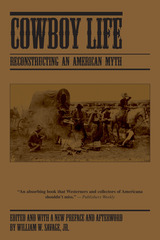 Cowboy Life: Reconstructing an American Myth
William W. Savage, Jr.
University Press of Colorado, 1993 First published in 1975 and now in paperback, Cowboy Life continues to be a landmark study on the historical and legendary dimensions of the cowboy. The central figure in American mythology, the cowboy can be seen everywhere: in films, novels, advertisements, TV, sports, and music. Though his image holds little resemblance to the historical cowboy, it is important because it represents many qualities with which Americans identify, including bravery, honor, chivalry, and individualism. Accounts by Joseph G. McCoy, Richard Irving Dodge, Charles A. Siringo, and many others detail the daily trials and tribulations of cowboy life on the southern Great Plains-particularly Texas, Indian Territory, and Kansas-from the 1860s to around 1900. And in a new Afterword, editor William W. Savage, Jr. discusses the directions the cowboy myth has taken in the past two decades, as well as the impact the "new Western history" and films such as Lonesome Dove have had on popular culture.
This edition contains a new preface and afterword by the author.
 Cowboy Park
Eduardo Martínez-Leyva
University of Wisconsin Press, 2024 “There are fevers you still wish to forget,” writes Eduardo Martínez-Leyva, but how fortunate for the rest of us that he remembers. These tenderly crafted autobiographical poems pierce through to the heart of pain, love, loss, and the ongoing search for salvation—or at least a salve. Housed in the lived experiences of a queer Latinx person born and raised in the border town of El Paso, Cowboy Park seamlessly blends themes of masculinity, identity, and the immigrant experience, offering a new perspective on the iconic image of the cowboy and a deeper understanding of the complexities of human experience.
The detainment and deportation of Martínez-Leyva’s brother grounds this exquisite collection in the all-too-common familial tragedy of political violence and discrimination. Martínez-Leyva honors the people, language, culture, and traditions that shaped him, revealing the indignities, large and small, experienced by a community that is too often misrepresented and maligned. “My voice was the only thing keeping us warm,” he writes, and the warmth from this striking debut collection is beautiful to behold.
 Cowboy Poets and Cowboy Poetry
Edited by David Stanley and Elaine Thatcher
University of Illinois Press, 2000 In bunkhouses or rodeo arenas, on the trail or around the campfire, cowboys have been creating and reciting poetry since the 1870s. In this comprehensive overview, folklorists, scholars, and cowboy poets join forces to explore the 125-year history and development of cowboy poetry and to celebrate those who sustain it.
Centered around six areas of focus, from historical background to biographical profiles to creative process, Cowboy Poets and Cowboy Poetry approaches the tradition of occupational folk poetry from a variety of perspectives. Contributors trace its history as an extension of the Homeric tradition of storytelling in verse and discuss such topics as the way a text evolves in retelling, how it becomes linked to a tune, and how poetic content fuses with form to generate narrative tension and humor.
Personal and telling portraits of cowboy poets and reciters--including D. J. O'Malley, Henry Herbert Knibbs, and a number of contemporary cowboy poets--illuminate the creative process through which individual poets work within a long community tradition, while comparative studies examine poetry by women, Mexican-American vaqueros, loggers, Argentine gauchos, and Australian bush poets.
Cowboy Poets and Cowboy Poetry offers the first in-depth examination of a distinctive and community-based tradition rich with larger-than-life heroes, vivid occupational language, humor, and unblinking encounters with birth, death, nature, and animals. Throughout, the collection shows that cowboy poetry interweaves two thematic strands: a fierce defense of an endangered way of life and a dynamic celebration of organic wholeness, camaraderie, and individualism.
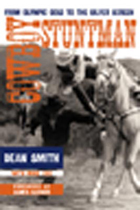 Cowboy Stuntman: From Olympic Gold to the Silver Screen
Dean Smith, with Mike Cox; foreword by James Garner
Texas Tech University Press, 2013
Dean Smith has taken falls from galloping horses, engaged in fistfights with Kirk Douglas and George C. Scott, donned red wig and white tights to double Maureen O’Hara, and taught Goldie Hawn how to talk like a Texan.
He’s dangled from a helicopter over the skyscrapers of Manhattan while clutching a damsel in distress, hung upside down from a fake blimp 200 feet over the Orange Bowl, and replicated one of the most famous scenes in movie history by climbing on a thundering team of horses to stop a runaway stagecoach.
Cowboy Stuntman chronicles the life and achievements of this colorful Texan and Olympic gold medal winner who spent a half century as a Hollywood stuntman and actor, appearing in ten John Wayne movies and doubling for a long list of actors as diverse as Robert Culp, Michael Landon, Steve Martin, Strother Martin, Robert Redford, and Roy Rogers.
Cowboys and Caudillos: Frontier Ideology of the Americas
Tom R. Sullivan
University of Wisconsin Press, 1990 Suggesting that better understanding of conflicts between Anglo and Latin America can come from the study of their contrasting popular fictions, the author compares the traditional attachment in Latin America to government by a strong man—a caudillo—to the diametrically opposed expansionist frontier ideology of the United States—the cowboy—who makes space safe for Anglo colonization.
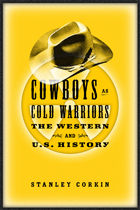 Cowboys As Cold Warriors: The Western And U S History
Stanley Corkin
Temple University Press, 2004 Though the United States emerged from World War II with superpower status and quickly entered a period of economic prosperity, the stresses and contradictions of the Cold War nevertheless cast a shadow over American life. The same period marked the heyday of the western film. Cowboys as Cold Warriors shows that this was no coincidence. It examines many of the significant westerns released between 1946 and 1962, analyzing how they responded to and influenced the cultural climate of the country. Author Stanley Corkin discusses a dozen films in detail, connecting them to each other and to numerous others. He considers how these cultural productions both embellished the myth of the American frontier and reflected the era in which they were made.
Films discussed include: My Darling Clementine, Red River, Duel in the Sun, Pursued, Fort Apache, Broken Arrow, The Gunfighter, High Noon, Shane, The Searchers, Gunfight at the OK Corral, The Magnificent Seven, The Alamo, Lonely Are the Brave, Ride the High Country, and The Man Who Shot Liberty Valance.
The Cowgirls
Joyce Gibson Roach
University of North Texas Press, 1990
Cowgirls of the Rodeo: Pioneer Professional Athletes
Mary Lou LeCompte
University of Illinois Press, 1993 Acclaimed as a foundational study of rodeo women, Cowgirls of the Rodeosurveys the early rodeo cowgirls' achievements as professional athletes. Mary Lou LeCompte follows the story through the near-demise of women's rodeo events during World War II and the phenomenal success of the Women's Professional Rodeo Association in regaining lost ground for rodeo cowgirls. Recalling an extraordinary chapter in women's history and the history of American sport, Cowgirls of the Rodeo deepens our understanding of the challenges facing women in the American West and in American sport.
The Cowherd's Son
Rajiv Mohabir
Tupelo Press, 2017 Rajiv Mohabir uses his queer and mixed-caste identities as grace notes to charm alienation into silence. Mohabir’s inheritance of myths, folk tales, and multilingual translations make a palimpsest of histories that bleed into one another. A descendant of indentureship survivors, the poet-narrator creates an allegorical chronicle of dislocations and relocations, linking India, Guyana, Trinidad, New York, Orlando, Toronto, and Honolulu, combining the amplitude of mythology with direct witness and sensual reckoning, all the while seeking joy in testimony.
Co-wives and Calabashes
Sally Price
University of Michigan Press, 1984 A fascinating exploration into the world of the Saramaka Maroons of the Suriname rain forest, Co-wives and Calabashes examines the status of women in this polygynous and matrilineal society as reflected in its social structure and in its art. The product of seventeen years of research, the book draws upon a rich variety of resources — from bawdy popular songs to dusty museum artifacts, from animated gossip sessions to comprehensive social statistics — to reveal the complex ways in which notions of gender, patterns of marriage, and the cultural definition of art are interrelated.
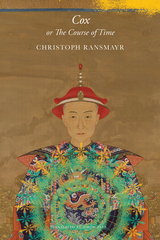 Cox: or, The Course of Time
Christoph Ransmayr
Seagull Books, 2020 Richly imagined and recounted in vivid prose of extraordinary beauty, this book is a stunning illustration of Ransmayr’s talent for imbuing a captivating tale with intense metaphorical, indeed metaphysical force.
The world’s most powerful man, Qiánlóng, emperor of China, invites the famous eighteenth-century clockmaker Alister Cox to his court in Beijing. There, in the heart of the Forbidden City, the Englishman and his assistants are to build machines that mark the passing of time as a child or a condemned man might experience it and that capture the many shades of happiness, suffering, love, and loss that come with that passing.
Mystified by the rituals of a rigidly hierarchical society dominated by an unimaginably wealthy, god-like ruler, Cox musters all his expertise and ingenuity to satisfy the emperor’s desires. Finally, Qiánlóng, also known by the moniker Lord of Time, requests the construction of a clock capable of measuring eternity—a perpetuum mobile. Seizing this chance to realize a long-held dream and honor the memory of his late beloved daughter, yet conscious of the impossibility of his task, Cox sets to work. As the court is suspended in a never-ending summer, festering with evil gossip about the monster these foreigners are creating, the Englishmen wonder if they will ever escape from their gilded cage. More than a meeting of two men, one isolated by power, the other by grief, this is an exploration of mortality and a virtuoso demonstration that storytelling alone can truly conquer time.
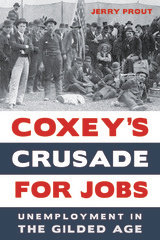 Coxey’s Crusade for Jobs: Unemployment in the Gilded Age
Jerry Prout
Northern Illinois University Press, 2016 In the depths of a depression in 1894, a highly successful Gilded Age businessman named Jacob Coxey led a group of jobless men on a march from his hometown of Massillon, Ohio, to the steps of the nation’s Capitol. Though a financial panic and the resulting widespread business failures caused millions of Americans to be without work at the time, the word unemployment was rarely used and generally misunderstood. In an era that worshipped the self-reliant individual who triumphed in a laissez-faire market, the out-of-work “tramp” was disparaged as weak or flawed, and undeserving of assistance. Private charities were unable to meet the needs of the jobless, and only a few communities experimented with public works programs. Despite these limitations, Coxey conceived a plan to put millions back to work building a nationwide system of roads and drew attention to his idea with the march to Washington.
In Coxey’s Crusade for Jobs, Jerry Prout recounts Coxey’s story and adds depth and context by focusing on the reporters who were embedded in the march. Their fascinating depictions of life on the road occupied the headlines and front pages of America’s newspapers for more than a month, turning the spectacle into a serialized drama. These accounts humanized the idea of unemployment and helped Americans realize that in a new industrial economy, unemployment was not going away and the unemployed deserved attention. This unique study will appeal to scholars and students interested in the Gilded Age and US and labor history.
 Coyote at the Kitchen Door: Living with Wildlife in Suburbia
Stephen DeStefano
Harvard University Press, 2010 A moose frustrates commuters by wandering onto the highway; a cougar stalks his prey through suburban backyards; an alligator suns himself in a strip mall parking lot. Such stories, which regularly make headline news, highlight the blurred divide that now exists between civilization and wilderness.
In Coyote at the Kitchen Door, Stephen DeStefano draws on decades of experience as a biologist and conservationist to examine the interplay between urban sprawl and wayward wildlife. As he explores what our insatiable appetite for real estate means for the health and well-being of animals and ourselves, he highlights growing concerns, such as the loss of darkness at night because of light pollution. DeStefano writes movingly about the contrasts between constructed and natural environments and about the sometimes cherished, sometimes feared place that nature holds in our modern lives, as we cluster into cities yet show an increasing interest in the natural world.
Woven throughout the book is the story of one of the most successful species in North America: the coyote. Once restricted to the prairies of the West, this adaptable animal now inhabits most of North America—urban and wild alike. DeStefano traces a female coyote’s movements along a winding path between landscapes in which her species learned to survive and flourish. Coyote at the Kitchen Door asks us to rethink the meaning of progress and create a new suburban wildlife ethic.
 Coyote Country: Fictions of the Canadian West
Arnold E. Davidson
Duke University Press, 1994 For most North Americans—Canadians as well as Americans—the term "Western" evokes images of the frontier, brave sheriffs and ruthless outlaws, good cowboys and bad Indians. As Arnold E. Davidson shows in this groundbreaking study, a number of Canada’s most interesting and experimental Western writers parody, reverse, or otherwise defuse the paraphernalia of the classic U.S. Western. Lacking both a real and imagined frontier—Canadian settlers rode trains into the new territory, already policed by Mounties—the writers of Canadian Westerns were set a different task from their American counterparts and were subsequently freed to create some of the most complex and engrossing fiction yet produced in Canada.
Davidson details the evolution of the U.S. and Canadian Western forms, tracing the divergence between the two as Canadian writers responded to their unique historical circumstances by reinventing the West as well as the Western and establishing a new literary landscape where author and reader could work out new possibilities of being. Surveying a range of texts by Canada’s most innovative writers, with special attention to women writers and Native stories of Coyote, he provides close readings of novels by Howard O’Hagan, Sheila Watson, Robert Kroetsch, Aritha van Herk, Anne Cameron, Peter Such, W. O. Mitchell, Beatrice Culleton, and Thomas King. A unique study, Coyote Country offers at one and the same time a theory of Canadian Western fiction, a history of crosscultural paradigms of the West as manifested in novels, and an intensive reading of some of Canada’s best literature.
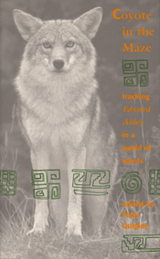 Coyote In The Maze
Peter Quigley
University of Utah Press, 1999 The works of Edward Abbey have been well known to general readers since the 1960’s. This volume, the first comprehensive collection of literary criticism devoted to the entire challenging corpus of Abbey’s fiction and nonfiction, couldn’t be more timely or significant.
From the perspective of his scholarly critics in Western American literature and environmental studies Ed Abbey is, in a word, problematic. As Peter Quigley, volume editor, comments, "The title of this collection refers to a number of references within Abbey’s work. The maze is a place of myriad canyons, of wonder, and a place where the desperadoes in The Monkey Wrench Gang could lose the authorities. The coyote refers to the slippery figure in Native American myth, a figure, known to Abbey, that always eluded definition an could slip out of every trap set to catch him." In this long-awaited anthology, eighteen intrepid scholars have chosen to ignore the coyote’s reputation, tracking Abbey in one masterful and illuminating essay after another through the canyons of anarchist politics, philosophy, feminist literary criticism, post-structuralism, and rhetoric, as well as nature and environmental theory and activism.
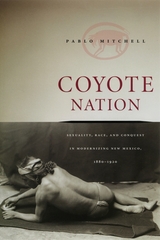 Coyote Nation: Sexuality, Race, and Conquest in Modernizing New Mexico, 1880-1920
Pablo Mitchell
University of Chicago Press, 2005 With the arrival of the transcontinental railroad in the 1880s came the emergence of a modern and profoundly multicultural New Mexico. Native Americans, working-class Mexicans, elite Hispanos, and black and white newcomers all commingled and interacted in the territory in ways that had not been previously possible. But what did it mean to be white in this multiethnic milieu? And how did ideas of sexuality and racial supremacy shape ideas of citizenry and determine who would govern the region?
Coyote Nation considers these questions as it explores how New Mexicans evaluated and categorized racial identities through bodily practices. Where ethnic groups were numerous and—in the wake of miscegenation—often difficult to discern, the ways one dressed, bathed, spoke, gestured, or even stood were largely instrumental in conveying one's race. Even such practices as cutting one's hair, shopping, drinking alcohol, or embalming a deceased loved one could inextricably link a person to a very specific racial identity.
A fascinating history of an extraordinarily plural and polyglot region, Coyote Nation will be of value to historians of race and ethnicity in American culture.
Coyote Steals Fire: A Shoshone Tale
Northwestern Band of the Shoshone Nation
Utah State University Press, 2005 "Coyote was tired of being cold," says this traditional Shoshone tale about the arrival of fire in the northern Wasatch region. Members of the Northwestern Band of the Shoshone Nation developed the concept for this retelling in collaboration with book arts teacher Tamara Zollinger. Together, they wrote and illustrated the book. Bright watercolor-and-salt techniques provide a winning background to the hand-cut silhouettes of the characters. The lively, humorous story about Coyote and his friends is complemented perfectly by later pages written by Northwestern Shoshone elders on the historical background and cultural heritage of the Shoshone nation. An audio CD with the voice of Helen Timbimboo telling the story in Shoshone and singing two traditional songs makes this book not only good entertainment but an important historical document, too.
Coyote Stories
Edited by William Bright
University of Chicago Press Journals, 1978 This volume includes 20 stories from a variety of languages spoken in the natural range of the coyote (Canis latrens). Each of the stories in this collection is presented in interlinearized format with full morpheme-by-morpheme glosses and English translations. This format makes explicit the structure of the language and illustrates the richness of grammar as it is used in context. This collection will be of interest to anthropologists, linguists, typologists, and aficionados of oral narrative, as well as to speakers and learners of Native American languages.
Coyote Stories II
Edited by Martha B. Kendall
University of Chicago Press Journals, 1980 This volume includes 12 stories from languages of the American southwest presented in numbered parallel format. Each of the stories in this collection is accompanied by morphological analyses and grammatical notes. This format makes explicit the structure of the language and illustrates the richness of grammar as it is used in context. These texts will be of interest to anthropologists, linguists, typologists, and aficionados of oral narrative, as well as to speakers and learners of Native American languages.
 Coyote Valley: Deep History in the High Rockies
Thomas G. Andrews
Harvard University Press, 2015 What can we learn from a high-country valley tucked into an isolated corner of Rocky Mountain National Park? In this pathbreaking book, Thomas Andrews offers a meditation on the environmental and historical pressures that have shaped and reshaped one small stretch of North America, from the last ice age to the advent of the Anthropocene and the latest controversies over climate change.
Large-scale historical approaches continue to make monumental contributions to our understanding of the past, Andrews writes. But they are incapable of revealing everything we need to know about the interconnected workings of nature and human history. Alongside native peoples, miners, homesteaders, tourists, and conservationists, Andrews considers elk, willows, gold, mountain pine beetles, and the Colorado River as vital historical subjects. Integrating evidence from several historical fields with insights from ecology, archaeology, geology, and wildlife biology, this work simultaneously invites scientists to take history seriously and prevails upon historians to give other ways of knowing the past the attention they deserve.
From the emergence and dispossession of the Nuche—“the People”—who for centuries adapted to a stubborn environment, to settlers intent on exploiting the land, to forest-destroying insect invasions and a warming climate that is pushing entire ecosystems to the brink of extinction, Coyote Valley underscores the value of deep drilling into local history for core relationships—to the land, climate, and other species—that complement broader truths. This book brings to the surface the critical lessons that only small and seemingly unimportant places on Earth can teach.
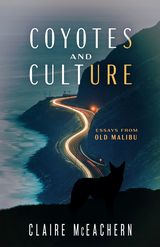 Coyotes and Culture: Essays from Old Malibu
Claire McEachern
University of Nevada Press, 2025 What do coyotes have to do with culture?
This unique collection of essays offers a gripping exploration of the precarious beauty and peril of California’s iconic coastline. Through essays blending personal narrative, cultural analysis, and history, author Claire McEachern takes us behind the scenes of surf and celebrities to paint a vivid portrait of life on the edge —both literally and metaphorically. From the rugged Santa Monica Mountains to the shimmering Pacific, this work captures the paradoxes of Old Malibu: a place of luxury and risk, natural splendor and ecological vulnerability.
As an East Coast academic married to a fifth-generation Californian cowboy, McEachern brings a wry yet tender lens to the modern American story, delving into what happens to love and community in a land of both devastating wildfires and extravagant wildflowers. Her reflections weave together questions of beauty, resilience, and humanity’s uneasy relationship with nature, creating an unforgettable narrative of place and survival. Readers drawn to the drama of human stories set against larger cultural and environmental forces will find this book both thought-provoking and deeply moving.
CP vol 108 num 1
The University of Chicago Press
University of Chicago Press Journals, 2013
CP vol 108 num 2
The University of Chicago Press
University of Chicago Press Journals, 2013
CP vol 108 num 3
The University of Chicago Press
University of Chicago Press Journals, 2013
CP vol 108 num 4
The University of Chicago Press
University of Chicago Press Journals, 2013
CP vol 109 num 1
The University of Chicago Press
University of Chicago Press Journals, 2014
CP vol 109 num 2
The University of Chicago Press
University of Chicago Press Journals, 2014
CP vol 109 num 3
The University of Chicago Press
University of Chicago Press Journals, 2014
CP vol 109 num 4
The University of Chicago Press
University of Chicago Press Journals, 2014
CP vol 110 num 1
The University of Chicago Press
University of Chicago Press Journals, 2015 This is volume 110 issue 1 of Classical Philology. Classical Philology (CP) has been an internationally respected journal for the study of the life, languages, and thought of the ancient Greek and Roman world since 1906. CP covers a broad range of topics, including studies that illuminate aspects of the languages, literatures, history, art, philosophy, social life, material culture, religion, and reception of ancient Greece and Rome.
CP vol 110 num 2
The University of Chicago Press
University of Chicago Press Journals, 2015
CP vol 110 num 3
The University of Chicago Press
University of Chicago Press Journals, 2015
CP vol 110 num 4
The University of Chicago Press
University of Chicago Press Journals, 2015
CP vol 111 num 1
The University of Chicago Press
University of Chicago Press Journals, 2016
CP vol 111 num 2
The University of Chicago Press
University of Chicago Press Journals, 2016
CP vol 111 num 3
The University of Chicago Press
University of Chicago Press Journals, 2016
CP vol 111 num 4
The University of Chicago Press
University of Chicago Press Journals, 2016
CP vol 112 num 1
The University of Chicago Press
University of Chicago Press Journals, 2017
CP vol 112 num 2
The University of Chicago Press
University of Chicago Press Journals, 2017
CP vol 112 num 3
The University of Chicago Press
University of Chicago Press Journals, 2017
CP vol 112 num 4
The University of Chicago Press
University of Chicago Press Journals, 2017
CP vol 113 num 1
The University of Chicago Press
University of Chicago Press Journals, 2018
CP vol 113 num 2
The University of Chicago Press
University of Chicago Press Journals, 2018
CP vol 113 num 3
The University of Chicago Press
University of Chicago Press Journals, 2018
CP vol 113 num 4
The University of Chicago Press
University of Chicago Press Journals, 2018
CP vol 114 num 1
The University of Chicago Press
University of Chicago Press Journals, 2019
CP vol 114 num 2
The University of Chicago Press
University of Chicago Press Journals, 2019
CP vol 114 num 3
The University of Chicago Press
University of Chicago Press Journals, 2019
CP vol 114 num 4
The University of Chicago Press
University of Chicago Press Journals, 2019
CP vol 115 num 1
The University of Chicago Press
University of Chicago Press Journals, 2020
CP vol 115 num 2
The University of Chicago Press
University of Chicago Press Journals, 2020
CP vol 115 num 3
The University of Chicago Press
University of Chicago Press Journals, 2020
CP vol 115 num 4
The University of Chicago Press
University of Chicago Press Journals, 2020
CP vol 116 num 1
The University of Chicago Press
University of Chicago Press Journals, 2021
 CR: The New Centennial Review 15, no. 1
Scott Michaelsen
Michigan State University Press Journals, 2015 IN THIS ISSUE
Editors’ Note
Special Section: Derrida and French Hegelianism
Rodolphe Gasché, "One Coming before the Other?: On Jean Wahl and Jacques Derrida"
Juan Manuel Garrido, "The Dialecticity of Mathematical Concepts and the Problem of the Origin of Geometry: Cavaillès avec Derrida"
Peter Gratton, "The Spirit of the Time: Derrida’s Reading of Hegel in the 1964–65 Lecture Course"
Mauro Senatore, "Of Seminal Differance: Dissemination and Philosophy of Nature"
Francesco Vitale, "Life Death and Differance: Philosophies of Life between Hegel and Derrida"
Francis Guibal, "Lévinas after Hegel: An Other Philosophy of Spirit?"
L Felipe Alarcón, "Restless Negativity: Blanchot’s Hegelianism"
María Victoria Londoño-Becerra, "The Question of the Other in the Dialectics of Time: The Problem of Intersubjectivity in Derrida’s Reading of Husserl"
Andrea Potestà, "When Negativity Runs the Risk of Meaning: Hegelian Heritages in Bataille and Derrida"
Roberto Saldías, "Derrida and Post-Hegelian Kantianism in Eric Weil: Impossibility and Possibility of Dialogue"
Article
Calvin L. Warren, "Black Nihilism and the Politics of Hope"
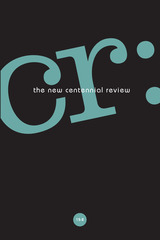 CR: The New Centennial Review 15, no. 2
Scott Michaelsen
Michigan State University Press Journals, 2015 IN THIS ISSUE
Editors’ Note
Special Section: W. E. B. Du Bois and the Question of Another World, II: (Or, Another Poetics and Another Writing—Of History and the Future)
Nahum Dimitri Chandler, "Introduction: Dry and Heavy: Or, Another Poetics and Another Writing—of History and the Future"
Alexander G. Weheliye, "Diagrammatics as Physiognomy: W. E. B. Du Bois’s Graphic Modernities"
Christopher Powers, "Figurations of Passage through 'Of the Coming of John'"
Kevin Thomas Miles, "Place Post-Paradise: Poetic Epistemology in The Souls of Black Folk"
Allison Blackmond Laskey, "Of Forms and Flow: Movement through Structure in Darkwater’s Composition"
Payal K. Patel, "On the Path of the Maharajah of Bwodpur: The Global Problem of the Color Line in W. E. B. Du Bois’s Dark Princess"
Lily Wiatrowski Phillips, "The Black Flame Revisited: Recursion and Return in the Reading of W. E. B. Du Bois’s Trilogy"
Ainsworth Clarke, "W. E. B. Du Bois’s Fugitive Writing, or Sociology at the Turn of the Twentieth Century"
R. A. Judy, "Lohengrin’s Swan and the Style of Interiority in 'Of the Coming of John'”
Article
Anthony Sze-Fai Shiu, "Marginality’s Marginalia: Difference and Plenary Power in Early Asian American Literature"
CR: The New Centennial Review 15, no. 3
Scott Michaelsen
Michigan State University Press Journals, 2015 IN THIS ISSUE
Editors’ Note
Special Section: Literature and the Limit
Philippe Lacoue-Labarthe, "The Abortion of Literature"
Brendan Corcoran, "'Antarctica' and Derek Mahon’s 'Topography of the Void'"
Tyler Williams, "How Faulkner Means Everything He Says: An Essay on James Baldwin’s Politics of Intentionality"
Sol Peláez, "Invaluable Literature: Eustasio Rivera’s La vorágine"
Michael W. Clune, "Can We Imagine Timeless Experience?"
Martin Hägglund, "Beauty That Must Die: A Response to Michael Clune"
Michael W. Clune and Martin Hägglund, "Time in Our Time: Clune and Hägglund Debating at Stanford"
Articles
Nicholas Heron, "What Is a Minister? Toward a Theory of the Instrumental Cause"
Fernanda Negrete, "Duras’s Césarée and the Subject of Love"
Aïcha Liviana Messina, "The Force and the Weakness of the Law: Grace and Disgrace in the Writing of Maurice Blanchot"
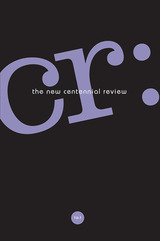 CR: The New Centennial Review 16, no. 1
Scott Michaelsen
Michigan State University Press Journals, 2016
IN THIS ISSUE
Editors’ Note
Special Issue: Translation and the Global Humanities
Pamela Beattie, Simona Bertacco, and Tatjana Soldat-Jaffe, "Introduction: Declining Translation"
Simona Bertacco, "An Interview with Emily Apter"
Jennifer Westerfeld, "Decipherment and Translation: An Egyptological Perspective"
Evelyn Nien-Ming Ch’ien, "Reinventing Translation: Icons and Dictionaries"
Esther Allen, "Vibrating States of Uncertainty"
Thomas E. Burman, "The Spacious Ironies of Translation"
Vicente L. Rafael, "Mutant Tongues: Translating English in the Postcolonial Humanities"
Rita Raley, "Algorithmic Translations"
Pamela M. Beattie, "The Ars and Translation: Ramon Llull’s Strategies for Communicating Truth"
Tatjana Soldat-Jaffe, "Translation: An Exercise in Midrashic Reading, or Translating the Intentio"
Simona Bertacco, "On Translation: Between Postcolonialism and the Global Humanities"
Clare E. Sullivan, "'I Am Those We Are Here': Multiplying Indigenous Voices through Poetic Translation"
Garry Sparks, "How ‘Bout Them Sapotes? Mendicant Translations and Maya Corrections in Early Indigenous Theologies"
Mary Louise Pratt, "Lessons for Losing"
CR: The New Centennial Review 16, no. 2
Scott Michaelsen
Michigan State University Press Journals, 2016 IN THIS ISSUE
Editor's Note
Special Section: James Baldwin’s Lives
Grant Farred, "Baldwin in Britain"
Michele Elam, "Baldwin’s Boys"
Emily J. Lordi, "James Baldwin and The Sound of Soul"
Magdalena J. Zaborowska, "Being James Baldwin, or Everything Is Personal"
Marisa Parham, "17, or, Tough, Dark, Vulnerable, Moody"
John E. Drabinski, "Baldwin’s Three Africans"
Terrion L. Williamson, "Bla(n)ckness and the Illogics of Black Teenage Motherhood"
Ashon Crawley, "That There Might Be Black Thought: Nothing Music and the Hammond B-3"
Ricardo A. Wilson II, "In the Blind: Alfonso Cuarón and the Question of Futurity"
Jack Taylor, "The Political Subjection of Bigger Thomas: The Gaze, Biopolitics, and The Court of Law in Richard Wright’s Native Son"
J. Kameron Carter and Sarah Jane Cervenak, "Black Ether"
CR: The New Centennial Review 16, no. 3
Scott Michaelsen
Michigan State University Press Journals, 2016 IN THIS ISSUE
Editors’ Note
Special Issie: Style
Scott R. Stroud, "Style and Spirit in Dreams of a Spirit-Seer: Swedenborg and the Origin of Kant’s Critical Rhetoric"
Donald Phillip Verene, "Speculative Philosophy and Speculative Style"
Gregory Whitlock, "Translating Nietzsche’s Zarathustra into English"
Héctor G. Castaño, "Corpus and Evidence: On Jean-Luc Nancy’s Style"
D. J. S. Cross, "Archaizing Style"
Jean-Michel Rabaté, "Excuse My French: Samuel Beckett’s Style of No Style"
Jean-Jacques Lecercle, "Three Accounts of Literary Style"
R. Andrés Guzmán, "Oscar “Zeta” Acosta and Generic Politics: At the Margins of Identity and Law"
Gabriel Horowitz, "The Natural History of Latin American Independence"
Cory Stockwell, "Sovereignty, Secrecy, and the Question of Magic in Roberto Bolaño’s Distant Star"
 CR: The New Centennial Review 17, no. 1
Scott Michaelsen
Michigan State University Press Journals, 2017 IN THIS ISSUE
Editors’ Note
Special Issue: Derrida, 1967
Marc Crépon, "Violence and Ethics"
Élise Lamy-Rested, "Derrida between Freud and Husserl: Husserlian Temporality and What Remains of It . . ."
Ronald Mendoza-de Jesús, "Historicity as Metaphoricity in Early Derrida: From the History of Being to Another Historiography"
Tze-Yin Teo, "Non-Event"
Mauro Senatore, "Renvoi (A Note on the Enigma of Derrida’s Differance)"
Scott Cutler Shershow, "Agriculture as “Writing”: Some Thoughts on the Contemporary Relevance of Derrida’s Of Grammatology"
Andrea Potestà, "Toward a 'rigorous writing of the cry': The Two Artauds of the First Derrida"
Laura Odello, "'The greatest possible mastery, the greatest possible self-presence of life': Derrida and the Deconstruction of Sovereignty"
Andrés Claro, "Poetic Image and Metaphysical Conception: Three Figures of the Literary Predecessors and Three Configurations of the Real"
CR: The New Centennial Review 17, no. 2
Scott Michaelsen
Michigan State University Press Journals, 2017 IN THIS ISSUE
Editors’ Note
Special Issue: Subjectivities
Rosaria Caldarone, "Subjectivity and Femininity: Reading Antigone"
Juan Manuel Garrido, "Self-Determination and Personal Identity:ANote on the Prenormative Roots of Moral Action"
Danielle Cohen-Levinas, "The Corporeal Meaning of Time: Phenomenology and Literature: Lévinas, Reader of Proust"
Pablo Oyarzún R., "External Things, the Subject, and Language: Lichtenberg and Kant"
Chantal Jaquet, "From the Self to Oneself: Subject and Interiority in Spinoza"
Eduardo Molina, "Kant’s Conception of the Subject"
Hugo E. Herrera, "Salomon Maimon on the Form of Thought and Consciousness"
Hernán Pringe, "Cohen and Natorp on Transcendental and Concrete Subjectivity"
Mario Ariel González Porta, "The Critique of Psychologism and the Conception of Subjectivity in Frege"
D. J. S. Cross, "Furtive Contemplations: Self, Time, and Affect in Deleuze"
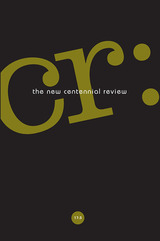 CR: The New Centennial Review 17, no. 3
Scott Michaelsen
Michigan State University Press Journals, 2017 IN THIS ISSUE
Editors' Note
Special Issue: Finitude
Rodolphe Gasché "'Infinitely Finite': Jean-Luc Nancy on History and Thinking"
María del Rosario Acosta López, "'An infinite task at the heart of finitude': Jean-Luc Nancy on Community and History"
Francesco Vitale, "Finite Infinity: Reading Gasché Reading Derrida Reading Hegel . . . 'and so on without an end'"
Aïcha Liviana Messina, "The End of the World and the Finitude of the World: (World, Christianity, and Finitude in Nancy and Blanchot)"
J. Colin McQuillan, "Kant, Heidegger, and the In/Finitude of Human Reason"
Miriam Jerade, " Mors certa, hora incerta: Derrida on Finitude and the Death Penalty"
Rosaura Martínez Ruiz, "Eros: Political Limit of the Death Drive"
Andrés Claro, "The Poetics of Time: Figures of Finitude, Figures of Infinitude"
D. J. S. Cross, "Apocrypha: Derrida’s Writing in Anti-Oedipus"
Juan Manuel Garrido Wainer, "From Time to Iterability: The Synthetic Operativity of Traces in Logical Forms"
Pablo Oyarzun R., "Fear and Abyss: Two Figures of Power"
Article
Gavin Arnall, "Repeating Translation, Left and Right (and Left Again): Roberto Bolaño’s Between Parentheses and Distant Star"
CR: The New Centennial Review 18, no. 1
Scott Michaelsen
Michigan State University Press Journals, 2018 IN THIS ISSUE
Editor's Note
Special Issue: Marc Crépon
Michael Naas, "Philosophy on the Western Front: Marc Crépon and the Trials of Violence in Our Times"
D. J. S. Cross, "In the Interest of Faith: Murder, Consent, and the Other Other"
Tyler M. Williams, "First Violence: Marc Crépon’s Faith in Literature ('if there is any')"
Aïcha Liviana Messina, "From the Saying to the Cry"
Articles
Ali Kulez, "Unburying the Specter: Postdictatorship Memory in Ricardo Piglia’s The Absent City (La ciudad ausente)"
Marquis Bey, "Pitch Black, Black Pitch: Theorizing African American Literature"
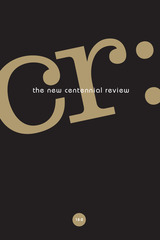 CR: The New Centennial Review 18, no. 2
Scott Michaelsen
Michigan State University Press Journals, 2018 IN THIS ISSUE
Editors’ Note
Special Issue: Music & Theory: New Ontologies, Politics, and Materialities
Claire Colebrook, "Escaping Meaning, Escaping Music"
Carolyn Chen, "Parts to Sing Empty"
Jeremy Braddock and Timothy Morton, "How to Make Hyperobject Sound Art: Occupying the Electromagnetic Field with the Firesign Theatre"
Joanna Bailie, "Film Theory and Synchronization"
Holly Watkins, "On Not Letting Sounds Be Themselves"
Fabien Lévy, "Deconstructing the Grammatologies of Music: A Tool for Composing"
Jeffrey R. Di Leo, "Late Capitalism on Vinyl: Neoliberalism, Biopolitics, and Music"
Christopher Swithinbank, "Who Vibrates?"
NaomiWaltham-Smith, "A Music Worthy of the Name: Or, Agamben’s Museicology"
Ashley Fure, "Liquid Chaos"
Jean-Luc Nancy, "Variations on the Reprise"
Tatiana Catanzaro, "The Breath of Sound"
Articles
Casey R. Goonan, "Sketches of Moral Duress: On the Analytics of White Liberal Ethicality—Mediating Crisis in the U.S. National (Racial) Form"
David L. Clark, “'Can the university stand for peace?': Omar Khadr, Higher Education, and the Question of Hospitality"
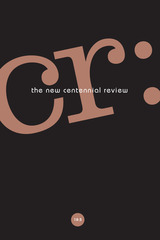 CR: The New Centennial Review 18, no. 3
Scott Michaelsen
Michigan State University Press Journals, 2018 IN THIS ISSUE
Editor's Note
Special Issue: What's Left of Marx?
John E. Drabinski, "Reproduction and the Universal in Glissant’s Later Work"
Grant Farred, "The Riddle of Identity Politics"
Stipe Grgas, "How Fares Marx in the Twenty-First Century?"
Jernej Habjan, "Rancière’s Lesson: October ’17, May ’68, October ’17"
Jean-Paul Martinon, "Marx 1845 or the Fateful Rejection of Anschauung"
Louis A. Ruprecht Jr., "Bringing Capital to Its Senses: French Iterations of Marxist Themes"
Articles
Stephanie Leigh Batiste, "My’s Silent Scream: Memory, Traumatic Time, and the Embodiment of the Black Surreal in Rickerby Hinds’s Dreamscape"
Paula Cucurella, "Coming into the Self: Autobiography and Masturbation"
James Edward Ford III, "The Difficult Miracle: Reading Phillis Wheatley against the Master’s Discourse"
Sharon Luk, "Ourselves at Stake: Social Reproduction in the Age of Prisons"
John G. Russell, "Darkies Never Dream: Race, Racism, and the Black Imagination in Science Fiction"
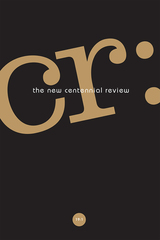 CR: The New Centennial Review 19, no. 1
Scott Michaelsen
Michigan State University Press Journals, 2019 IN THIS ISSUE
Editors’ Note
Special Issue: Speculative Finance/Speculative Fiction
David M. Higgins and Hugh C. O’Connell, "Introduction: Speculative Finance/Speculative Fiction"
Sherryl Vint, "Promissory Futures: Reality and Imagination in Finance and Fiction"
Mathias Nilges, "The Realism of Speculation: Contemporary Speculative Fiction as Immanent Critique of Finance Capitalism"
David M. Higgins, "A Glorious Mythology of Loss: Speculative Finance in Alan Moore’s Jerusalem"
Joel E. Mason, with Michael Hornblow and anique yael vered, "The Great Dividuation"
Mark Soderstrom, "Future Fluctuations: Economy, Exchange, and Subjectivity in Recent English-Language Speculative Fiction"
Hugh C. O’Connell, "The Novums of Fiscalmancy: Speculative Finance and Speculative Fiction in Ian McDonald’s The Dervish House"
Joshua Pearson, "Frank Herbert’s Dune and the Financialization of Heroic Masculinity"
Steve Asselin, "Apocalypse, Inc.: Incorporating the Environment into the Boom/Bust Cycle in Fin-de-Siècle Science Fiction"
Meghanne Flynn and Sarah Hardstaff, "'Trust Me': Volatile Markets in Twilight and The Hunger Games"
Joe Conway, Currencies of Control: Black Mirror, In Time, and the Monetary Policies of Dystopia
David P. Pierson, "Speculative Finance and Network Temporality in Duncan Jones’s Moon and Source Code"
Marcia Klotz, "Of Time Loops and Derivatives: Christopher Nolan’s Interstellar and the Logic of the Futures Market"
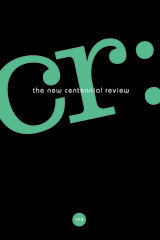 CR: The New Centennial Review 19, no. 2
Scott Michaelsen
Michigan State University Press Journals, 2019 IN THIS ISSUE
Editor's Note
Articles
W. Andrew Shephard, “'All Is Always Now': Slavery, Retrocausality, and Recidivistic Progress in Samuel R. Delany’s Empire Star (1966)"
John Paul Ricco, "Mourning, Melancholia, Moonlight"
Richard Block, "Heinrich Heine’s The Rabbi of Bacherach and the Ends of Judaism"
Renee Hudson, "Former Futures and Absent Histories in María Cristina Mena, Rosaura Sánchez, and Beatrice Pita"
Shaun Irlam, "Terrortories: Geographies of Genocide in Rwanda"
Keren Omry, "Ozeki’s Mirror Rooms: Posthumanism and A Tale for the Time Being"
Derek Beaudry, "The Abject Architecture of Decontainment in the Mexico of Sergio González Rodríguez"
Roshaya Rodness, "Cinema’s Queer Witness: Ira Sachs’s Last Address and the Indifferent View"
Anthony Sze-Fai Shiu, "Exception(al): Apprehending the Unexpected in Japanese American Internment Literature"
Jensen Suther, "Allegories of the Future: Towards a Critical Theory of Surrealism"
Nibras Chehayed, "Nietzsche and Gadamer on Truth and Interpretation"
CR: The New Centennial Review 19, no. 3
Scott Michaelsen
Michigan State University Press Journals, 2020 In This Issue
Editors’ Note
Special Issue: After Biodeconstruction
Francesco Vitale, "What (Bio)deconstruction Is Not"
Michael Naas, "Learning to Read 'Life Death' Finally: Francesco Vitale’s Epigenetic Criticism"
Matthias Fritsch, "From Bio- to Eco-Deconstruction"
Philippe Lynes, "After Biodeconstruction in the Neganthropocene"
Thomas Clément Mercier, "Resisting the Present: Biopower in the Face of the Event (Some Notes on Monstrous Lives)"
Juan Manuel Garrido Wainer, "Knowledge Production and Knowledge of Life"
Sorelle Henricus, "Signatures of Life: Thinking the Logos of Life After Biodeconstruction"
Jonathan Basile, "Kant’s Parasite: Sublime Biodeconstruction"
Satoru Yoshimatsu, "Auto-Affective and Self-Referential Structure of Life in Derrida"
Erin Obodiac, "Autoimmune Cinema"
Article
Irving Goh, "Introducing Touching Literature: Anthony Doerr’s All the Light We Cannot See"
 CR: The New Centennial Review 20, no. 1
Scott Michaelsen
Michigan State University Press Journals, 2020 In This Issue
Editors’ Note
Special Issue: Variations on Democracy
Articles
Tyler M. Williams, "Derrida and the Censorship of Literature"
Kate Jenckes, "Intersections of Politics, Philosophy, Aesthetics, and Life in Contemporary Chilean Criticism and Art"
Ashley Brock, "Reanimating the Domestic Still Life"
Jeannine Murray-Román, "Errors in the Exchange: Debt, Self-Translation, and the Speculative Poesis of Raquel Salas Rivera"
Patrick Dove, "The Impotence of Sovereignty: Temporality and Repetition in History"
Víctor M. Pueyo Zoco, "On Impure Communism: Rethinking Radical Democracy in Two Early Latin American Colonial Utopias (1516–32)"
Adam Joseph Shellhorse, "The Verbivocovisual Revolution: Anti-Literature, Affect, Politics, and World Literature in Augusto de Campos"
Paula Cucurella, "Beauty Is a Thing of the Past: The Idiom, the Monster, and the Democratic Health of Our Disciplines"
 CR: The New Centennial Review 20, no. 2
Scott Michaelsen
Michigan State University Press Journals, 2020 In This Issue
From the Editor
Special Section: Violence
Rodolphe Gasché, "Violence, Brutality, Cruelty: On Differentiation (and Its Refusal)"
Francesco Vitale, "On the Other Side of the Drive for Power: Transcendental Violence and Its Deconstruction"
Stephen D. Gingerich "'No Servir de Nada': Ana María Matute’s and Georges Bataille’s Literatures of Infantile Violence"
Enrique Díaz Álvarez, "The Art of Resistance: On War, Politics, and the Power of Public Mourning in Mexico"
Special Section: Mexican Crime Novel
Florence Olivier, "Chronicles, Fictions, Non-Fiction Novels: The Power and Powerlessness of Literature against the Illegal Drug Trade"
Antoine Ducoux, "The Journalist and the Mexican “War on Drugs” between Chronicle and Fiction: Edgar Piñon Balderrama, Don Winslow, and Luis Humberto Crosthwaite"
Derek Beaudry, "'Democracy against the State' in The Mongolian Conspiracy by Rafael Bernal"
Articles
Masatake Shinohara, "Rethinking the Human Condition in the Ecological Collapse"
Marquis Bey, "Incorporeal Blackness: A Theorization in Two Parts—Rachel Dolezal and Your Face in Mine"
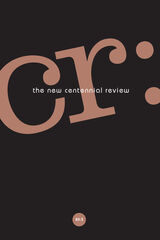 CR: The New Centennial Review 20, no. 3
Scott Michaelsen
Michigan State University Press Journals, 2020 In This Issue
Editors’ Note
Special Issue: American Literary Naturalism and the World
Christopher L. Hill, "American Naturalism’s Worldly History"
Bryan Yazell and Hsuan L. Hsu, "Naturalist Compulsion, Racial Divides, and the Time-Loop Zombie"
Chuck Robinson, "Scale Shifts from Polk Street to a Broken Earth; or, Literary Naturalism’s Geontological Affordances"
L. Ashley Squires, "From Anticapitalist Polemic to Novel of Success: Reader Reception of Theodore Dreiser’s The Financier in Soviet Successor States"
Jericho Williams, "Of Vanity, Fake News, and Flair: Naturalism’s International Entrance into Harlem in Claude McKay’s Amiable with Big Teeth"
Daniel Mrozowski, "Over Here: America’s Great War Mobilization and Transnational Alternatives in Mary Austin and Ellen Glasgow
Cara Erdheim Kilgallen, "Naturalism’s International Identity: Anti-Semitism, Alienation, and Women’s Writing"
Kylan Rice, "A 'Correspondence of Eyes with Eyes': Edwin Arlington Robinson, Empathy, and Literary Naturalism"
CR: The New Centennial Review 21, no. 1
Scott Michaelsen
Michigan State University Press Journals, 2021 In This Issue
Editors’ Note
Introduction
Jan Mieszkowski and Julia Ng, "Introduction: No Time for Linear Time"
Articles
Julia Ng, "Undecidability and Reversibility"
Jake Fraser, "Turning Back Time: Friedrich Kittler, Reversibility, and Media of Time Axis Manipulation"
Kevin McLaughlin, "Delimiting Literary Criticism: Walter Benjamin’s Dissertation"
Christopher D. Johnson, "Arcadian Gestures in an Irreversible World: Stoppard, Serres, and Panofsky"
Jonas Rosenbrück, "Palindromitis: Reversibility, Undoing, and the Time of Language"
Brian McGrath, "Reverse Cannot Befall"
Jan Mieszkowski, "Language Swaps: On the Reversibility of Translation"
Deborah Goldgaber, "On Recovering the Past: Textual “Reversibility” in M. NourbeSe Philip’s Zong!"
Erin Shevaugn Schlumpf, "Exhaustion: In Defiance of Homogeneous Empty Time"
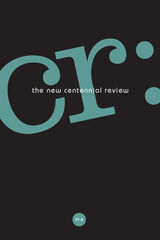 CR: The New Centennial Review 21, no. 2
Scott Michaelsen
Michigan State University Press Journals, 2021 In This Issue
AIDS: Remains
Editors’ Note
Introduction
Introduction
Richard Block, Kathleen Chapman, and Mia Du Plessis
Articles
AIDS Remains: An Opening
Mia Du Plessis
Layers of Disaster
Anna Blume
Pose in the COVID Crisis: Reflections on Watching Pandemics through the Small Screen
Tobias Wofford
Mourning Becomes Electric: The Disappearing Act of AIDS
Richard Block
Follow My Trace Like That of AIDS: A Digression
Alexander García Düttmann
Blood/Loss: Toward a Queer Poetics of Embodied Memory (a Love Story)
Keiko Lane
Show Me the Color of Your Flowers: American AIDS Poetry Today
Brian Reed
Against Vanishing: Cookie Mueller and Nan Goldin
Kathleen Chapman and Mia Du Plessis
Bad Blood: Visual Rhetorics of HIV/AIDS in the Contemporary American South
Christopher Garland
Kafka
K.’s Debt: The Economy of The Trial
Wayne Stables
A Dyad on Comedy
Reading Jokes
Scott Cutler Shershow
Did You Hear the One about Žižek and the Aristocrats?: Thinking through an Abject Joke and Its Perverse Retelling
Louis Kaplan
CR: The New Centennial Review 22, no. 1
Scott Michaelsen
Michigan State University Press Journals, 2022 Contents
Editors’ Introduction
(In)finite Ecologies
Introduction: (In)Finite Ecologies
Katie Greulich
Abundance Against Scarcity
Heather Houser
The Immanent Infinite
Claire Colebrook
The Need for a Black Feminist Climate Justice: A Case of Haunting Ecology and Eco-Deconstruction
Romy Opperman
Nature Is Healing: Reading COVID-19 Narratives Through the Fantasy of Infinite Nature at Chernobyl
K. M. Ferebee
The Phoenix Complex
Michael Marder
Prosthetic Symbiosis
Derek Woods
Camera Work: The Erotics and Ethics of Modern Ecology
Katie Greulich
Article
Black Universals and Alain Locke’s Notion of Value
Surya Parekh
CR: The New Centennial Review 22, no. 2
Scott Michaelsen
Michigan State University Press Journals, 2022 Twenty-First-Century Religion(s) and Spiritualities
Introduction: From Kaleidoscopes to Phantasmagoria
Morgan Shipley
Poetry as Spiritual Exercise: On A. R. Ammons
Kevin Hart
Delimiting Religion: From Religious Experience to Relational Research
James L. Cox
Religion in the Twenty-First Century: Whither Being Spiritual but Not Religious
William B. Parsons
The Day the World Stopped Working: Jacques Derrida, Jeremy Rifkin, and the Theology of Work
Michael Naas
Religion, Environmental Crisis, Fascism
Roger S. Gottlieb
“How Does Nature Deify Us”: Disney, Climate Change, and the Worship of the Self
Michael J. Blouin and Morgan Shipley
Mormonicity
Lydia R. Kerr
Back to the Future: The Postsecular Literary Imaginary in Maggie Nelson and Ben Lerner
Kyra Sutton
Mystical Emulations, Inverted Echoes: “Adonai Is Mistaken” and the “God Minus” Reinterpretation of Nietzsche
Nathan D. Frank
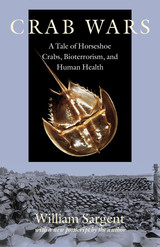 Crab Wars: A Tale of Horseshoe Crabs, Bioterrorism, and Human Health
William Sargent
University Press of New England, 2006 Surviving almost unmolested for 300 million years, the horseshoe crab is now the object of an intense legal and ethical struggle involving marine biologists, environmentalists, US government officials, biotechnologists, and international corporations. The source of this friction is the discovery 25 years ago that the blood of these ancient creatures serves as the basis for the most reliable test for the deadly and ubiquitous gram-negative bacteria. These bacteria are responsible for life-threatening diseases like menengitis, typhoid, E. coli, Legionnaire’s Disease and toxic shock syndrome. Because every drug certified by the FDA must be tested using the horseshoe crab derivative known as Limulus lysate, a multimillion dollar industry has emerged involving the license to “bleed” horseshoe crabs and the rights to their breeding grounds. Since his youthful fascination with these ancient creatures, William Sargent has spent much of his life observing, studying, and collecting horseshoe crabs. As a result, he presents a thoroughly accessible insider’s guide to the discovery of the lysate test, the exploitation of the crabs at the hands of multinational pharmaceutical conglomerates, local fishing interests, and the legal and governmental wrangling over the creatures’ ultimate fate. In the end, the story of the horseshoe crab is a sobering reflection on the unintended consequences of scientific progress and the danger of self-regulated industries controlling a limited natural resource.
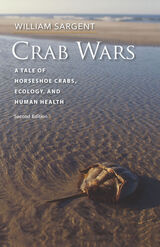 Crab Wars: A Tale of Horseshoe Crabs, Ecology, and Human Health
William Sargent
Brandeis University Press, 2021 A timely look at the exploitation of a species that has helped with the development of countless drugs and is fast becoming endangered.
Because every drug certified by the FDA must be tested using the horseshoe crab derivative known as Limulus lysate, a multimillion-dollar industry has emerged involving the license to bleed horseshoe crabs and the rights to their breeding grounds. William Sargent presents a thoroughly accessible insider’s guide to the discovery of the lysate test, the exploitation of the horseshoe crab at the hands of multinational pharmaceutical conglomerates, local fishing interests, and the legal and governmental wrangling over the creatures’ ultimate fate. In the end, the story of the horseshoe crab is a sobering reflection on the unintended consequences of scientific progress and the danger of self-regulated industries controlling a limited natural resource. This new edition brings the story up to date as companies race to manufacture alternatives to the horseshoe crab blood, which is now essential for testing vaccines such as those developed to counter COVID-19. However, horseshoe crab populations are still dwindling, with profound implications not only for the future of the crabs themselves but also for the ecosystems that depend on them.
 Crabgrass Catholicism: How Suburbanization Transformed Faith and Politics in Postwar America
Stephen M. Koeth
University of Chicago Press, 2025 How suburbanization was a crucial catalyst for reforms in the Catholic Church.
The 1960s in America were a time of revolt against the stifling conformism embodied in the sprawling, uniform suburbs of the 1950s. Typically, the reforms of the Catholic Church’s Second Vatican Council, which aimed to make the Church more modern and accessible, are seen as one result of that broader cultural liberalization. Yet in Crabgrass Catholicism, Stephen M. Koeth demonstrates that the liberalization of the Church was instead the product of the mass suburbanization that began some fifteen years earlier. Koeth argues that postwar suburbanization revolutionized the Catholic parish, the relationship between clergy and laity, conceptions of parochial education, and Catholic participation in US politics, and thereby was a significant factor in the religious disaffiliation that only accelerated in subsequent decades.
A novel exploration of the role of Catholics in postwar suburbanization, Crabgrass Catholicism will be of particular interest to urban historians, scholars of American Catholicism and religious studies, and Catholic clergy and laity.
The Crable Site, Fulton County, Illinois: A Late Prehistoric Site in the Central Illinois Valley
Hale Gilliam Smith
University of Michigan Press, 1951 The Crable site is a late prehistoric site in Fulton County in west-central Illinois, along the Illinois River. In this report, Hale Gilliam Smith combines results from the University of Chicago’s excavation in 1933 with information from local collectors in order to present a description and analysis of the site. Archaeologists uncovered burial mounds, fire pits, and a cemetery; artifacts included ceramics, chipped stone tools, and shell ornaments.
Crack Capitalism
John Holloway
Pluto Press, 2010 Crack Capitalism, argues that radical change can only come about through the creation, expansion and multiplication of 'cracks' in the capitalist system. These cracks are ordinary moments or spaces of rebellion in which we assert a different type of doing.
John Holloway's previous book, Change the World Without Taking Power, sparked a world-wide debate among activists and scholars about the most effective methods of going beyond capitalism. Now Holloway rejects the idea of a disconnected array of struggles and finds a unifying contradiction - the opposition between the capitalist labour we undertake in our jobs and the drive towards doing what we consider necessary or desirable.
Clearly and accessibly presented in the form of 33 theses, Crack Capitalism is set to reopen the debate among radical scholars and activists seeking to break capitalism now.
The Crack In Everything
Alicia Suskin Ostriker
University of Pittsburgh Press, 1996 This volume of poetry from Alicia Suskin Ostriker is one of her most ambitious, ranging from laments and celebrations for a flawed world to meditations on art and artists, to a powerful exploration of illness and healing.
 Crack Mothers: Pregnancy, Drugs and the Media
Drew Humphries
Ohio State University Press, 1999 In Crack Mothers, Drew Humphries asserts that medicine and criminal justice have always been at odds on the subject of drug use. The one treats drug users as patients, the other as criminals. However, beginning in the late 1980s, the “crack mother” scare led to an unprecedented alliance between doctors and prosecutors in some states, where doctors turned addicted pregnant women over to the police for arrest, trial, and incarceration. Humphries analyzes the public reaction to crack cocaine and the policies instituted to combat it. She shows us that, more often than not, policies were generated by the fears that crack mothers were harbingers of even more serious social problems. The media’s construction of the crack mother as a model of depravity, she argues, reflects mainstream desires and fears, rather than portraying the truth. Humphries offers a more balanced view of the women who use crack and the policies that have been adopted to stop them. Humphries does not dwell on the transgressions of crack mothers, nor does she endorse the punitive measures of the drug war policy makers. After ten years of studying a wide range of state policies, she finds that zero tolerance, mandatory sentences, and interdiction have not only failed to reduce drug use but increased the sense of persecution among the urban poor and contributed to the crisis of overcrowding in courts and prisons. Moreover, she states, before crack mothers became a media spectacle, no one had considered the special needs of women in designing drug treatment programs. Crack Mothers is a timely and important contribution to our growing understanding of maternal health, drug use, and treatment.
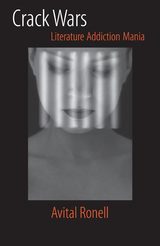 Crack Wars: LITERATURE ADDICTION MANIA
Avital Ronell
University of Illinois Press, 1992 Avital Ronell asks why "there is no culture without drug culture." She deals with the usual drugs and alcohol (and their celebrities: Freud's cocaine, Baudelaire's hashish, the Victorians' laudanum), and moves beyond them to addictions that are culturally accepted--an insatiable appetite for romance novels, for instance, and romance itself.
It is a commonplace of modern culture to presume that there is a subculture or counterculture deeply saturated with drugs, but such modern cultures need subcultures, and need drugs on every level. Culture defines itself, its classes, its power structures, and its economy in terms of how it allows and encourages drugs to circulate. If drugs are dangerous, that danger seems to increase their appeal for millions. If drugs are unnatural and addictive, gasoline is a drug. What is art but a kind of drug, and what is art criticism but a kind of criticism of drugs and drug-induced states?
Gustave Flaubert's Madame Bovary takes up the problems of drugs and addiction in numerous ways, which Ronnell unpacks and presents as examples of the safe and unsafe. From Emma Bovary's romantic hallucinations to her suicide by arsenic, she moves through this realistic novel constantly reaching for the unreal. For Ronell, Emma Bovary represents the first addict, embodying a yearning that calls from the bottom of her humanity, and which it seems can only be satisfied by some sort of drug.
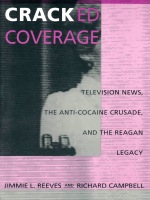 Cracked Coverage: Television News, The Anti-Cocaine Crusade, and the Reagan Legacy
Jimmie L. Reeves and Richard Campbell
Duke University Press, 1994 Carefully documenting the deceptions and excesses of television news coverage of the so-called cocaine epidemic, Cracked Coverage stands as a bold indictment of the backlash politics of the Reagan coalition and its implicit racism, the mercenary outlook of the drug control establishment, and the enterprising reporting of crusading journalism. Blending theoretical and empirical analyses, Jimmie L. Reeves and Richard Campbell explore how TV news not only interprets "reality" in ways that reflect prevailing ideologies, but is in many respects responsible for constructing that reality. Their examination of the complexity of television and its role in American social, cultural, and political conflict is focused specifically on the ways in which American television during the Reagan years helped stage and legitimate the "war on drugs," one of the great moral panics of the postwar era.
The authors persuasively argue, for example, that powder cocaine in the early Reagan years was understood and treated very differently on television and by the state than was crack cocaine, which was discovered by the news media in late 1985. In their critical analysis of 270 news stories broadcast between 1981 and 1988, Reeves and Campbell demonstrate a disturbing disparity between the earlier presentation of the middle- and upper-class "white" drug offender, for whom therapeutic recovery was an available option, and the subsequent news treatment of the inner-city "black" drug delinquent, often described as beyond rehabilitation and subject only to intensified strategies of law and order. Enlivened by provocative discussions of Nancy Reagan’s antidrug activism, the dramatic death of basketball star Len Bias, and the myth of the crack baby, the book argues that Reagan’s war on drugs was at heart a political spectacle that advanced the reactionary agenda of the New and Religious Right—an agenda that dismissed social problems grounded in economic devastation as individual moral problems that could simply be remedied by just saying "no."
Wide ranging and authoritative, Cracked Coverage: Television News, the Anti-Cocaine Crusade, and the Reagan Legacy is a truly interdisciplinary work that will attract readers across the humanities and social sciences in addition to students, scholars, journalists, and policy makers interested in the media and drug-related issues.
 Cracked Coverage: Television News, The Anti-Cocaine Crusade, and the Reagan Legacy
Jimmie L. Reeves and Richard Campbell
Duke University Press Carefully documenting the deceptions and excesses of television news coverage of the so-called cocaine epidemic, Cracked Coverage stands as a bold indictment of the backlash politics of the Reagan coalition and its implicit racism, the mercenary outlook of the drug control establishment, and the enterprising reporting of crusading journalism. Blending theoretical and empirical analyses, Jimmie L. Reeves and Richard Campbell explore how TV news not only interprets "reality" in ways that reflect prevailing ideologies, but is in many respects responsible for constructing that reality. Their examination of the complexity of television and its role in American social, cultural, and political conflict is focused specifically on the ways in which American television during the Reagan years helped stage and legitimate the "war on drugs," one of the great moral panics of the postwar era.
The authors persuasively argue, for example, that powder cocaine in the early Reagan years was understood and treated very differently on television and by the state than was crack cocaine, which was discovered by the news media in late 1985. In their critical analysis of 270 news stories broadcast between 1981 and 1988, Reeves and Campbell demonstrate a disturbing disparity between the earlier presentation of the middle- and upper-class "white" drug offender, for whom therapeutic recovery was an available option, and the subsequent news treatment of the inner-city "black" drug delinquent, often described as beyond rehabilitation and subject only to intensified strategies of law and order. Enlivened by provocative discussions of Nancy Reagan’s antidrug activism, the dramatic death of basketball star Len Bias, and the myth of the crack baby, the book argues that Reagan’s war on drugs was at heart a political spectacle that advanced the reactionary agenda of the New and Religious Right—an agenda that dismissed social problems grounded in economic devastation as individual moral problems that could simply be remedied by just saying "no."
Wide ranging and authoritative, Cracked Coverage: Television News, the Anti-Cocaine Crusade, and the Reagan Legacy is a truly interdisciplinary work that will attract readers across the humanities and social sciences in addition to students, scholars, journalists, and policy makers interested in the media and drug-related issues.
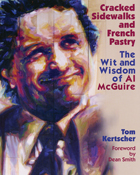 Cracked Sidewalks and French Pastry: The Wit and Wisdom of Al McGuire
Tom Kertscher
University of Wisconsin Press, 2002
Al McGuire was the Mark Twain of college basketball. Never was there a figure in the game so quoted and so quotable, on sports and on the human condition. This book collects more than a hundred of McGuire’s most colorful quotations, plus photographs from his life and career, in a tribute that is funny, poignant, and brimming with his streetwise sagacity.
McGuire, a brash and fiery New Yorker who grew up working in his parents’ saloon, played a rough and tumble game of basketball at St. John’s University and briefly in the NBA before entering the coaching ranks. He reached the pinnacle of his profession and gained national fame at Marquette University in Milwaukee, where in thirteen seasons he compiled a 295-80 record, appeared in nine NCAA tournaments, and won eighty-one home games in a row. He was a fine coach who cared deeply about his players and was beloved by his teams and fans alike, but his flamboyance and his mouth sometimes got him into trouble. The end of his coaching career captivated the nation: McGuire wept on the bench as his Marquette Warriors won the national title.
McGuire then began a ground-breaking career in network broadcasting, adding a zest and unconventionality that the college game had never seen. His sometimes bizarre and always entertaining commentary kept viewers tuned in even after the outcome of a lopsided game was a foregone conclusion. When Al McGuire died of leukemia in 2001, the sports world lost a true original.
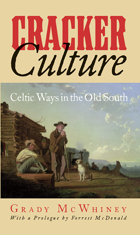 Cracker Culture: Celtic Ways in the Old South
Grady McWhiney
University of Alabama Press, 1989 Cracker Culture is a provocative study of social life in the Old South that probes the origin of cultural differences between the South and the North throughout American history. Among Scotch-Irish settlers the term “Cracker” initially designated a person who boasted, but in American usage the word has come to designate poor whites. McWhiney uses the term to define culture rather than to signify an economic condition. Although all poor whites were Crackers, not all Crackers were poor whites; both, however, were Southerners. The author insists that Southerners and Northerners were never alike. American colonists who settled south and west of Pennsylvania during the 17th and 18th centuries were mainly from the “Celtic fringe” of the British Isles. The culture that these people retained in the New World accounts in considerable measure for the difference between them and the Yankees of New England, most of whom originated in the lowlands of the southeastern half of the island of Britain. From their solid base in the southern backcountry, Celts and their “Cracker” descendants swept westward throughout the antebellum period until they had established themselves and their practices across the Old South. Basic among those practices that determined their traditional folkways, values, norms, and attitudes was the herding of livestock on the open range, in contrast to the mixed agriculture that was the norm both in southeastern Britain and in New England. The Celts brought to the Old South leisurely ways that fostered idleness and gaiety. Like their Celtic ancestors, Southerners were characteristically violent; they scorned pacifism; they considered fights and duels honorable and consistently ignored laws designed to control their actions. In addition, family and kinship were much more important in Celtic Britain and the antebellum South than in England and the Northern United States. Fundamental differences between Southerners and Northerners shaped the course of antebellum American history; their conflict in the 1860s was not so much brother against brother as culture against culture.
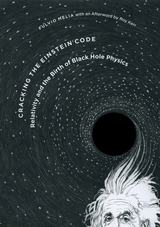 Cracking the Einstein Code: Relativity and the Birth of Black Hole Physics
Fulvio Melia
University of Chicago Press, 2009 Albert Einstein’s theory of general relativity describes the effect of gravitation on the shape of space and the flow of time. But for more than four decades after its publication, the theory remained largely a curiosity for scientists; however accurate it seemed, Einstein’s mathematical code—represented by six interlocking equations—was one of the most difficult to crack in all of science. That is, until a twenty-nine-year-old Cambridge graduate solved the great riddle in 1963. Roy Kerr’s solution emerged coincidentally with the discovery of black holes that same year and provided fertile testing ground—at long last—for general relativity. Today, scientists routinely cite the Kerr solution, but even among specialists, few know the story of how Kerr cracked Einstein’s code. Fulvio Melia here offers an eyewitness account of the events leading up to Kerr’s great discovery. Cracking the Einstein Code vividly describes how luminaries such as Karl Schwarzschild, David Hilbert, and Emmy Noether set the stage for the Kerr solution; how Kerr came to make his breakthrough; and how scientists such as Roger Penrose, Kip Thorne, and Stephen Hawking used the accomplishment to refine and expand modern astronomy and physics. Today more than 300 million supermassive black holes are suspected of anchoring their host galaxies across the cosmos, and the Kerr solution is what astronomers and astrophysicists use to describe much of their behavior. By unmasking the history behind the search for a real world solution to Einstein’s field equations, Melia offers a first-hand account of an important but untold story. Sometimes dramatic, often exhilarating, but always attuned to the human element, Cracking the Einstein Code is ultimately a showcase of how important science gets done.
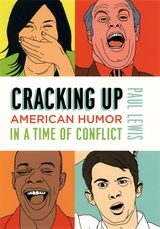 Cracking Up: American Humor in a Time of Conflict
Paul Lewis
University of Chicago Press, 2006 What do Jon Stewart, Freddy Krueger, Patch Adams, and George W. Bush have in common? As Paul Lewis shows in Cracking Up, they are all among the ranks of joke tellers who aim to do much more than simply amuse. Exploring topics that range from the sadistic mockery of Abu Ghraib prison guards to New Age platitudes about the healing power of laughter, from jokes used to ridicule the possibility of global climate change to the heartwarming performances of hospital clowns, Lewis demonstrates that over the past thirty years American humor has become increasingly purposeful and embattled.
Navigating this contentious world of controversial, manipulative, and disturbing laughter, Cracking Up argues that the good news about American humor in our time—that it is delightful, relaxing, and distracting—is also the bad news. In a culture that both enjoys and quarrels about jokes, humor expresses our most nurturing and hurtful impulses, informs and misinforms us, and exposes as well as covers up the shortcomings of our leaders. Wondering what’s so funny about a culture determined to laugh at problems it prefers not to face, Lewis reveals connections between such seemingly unrelated jokers as Norman Cousins, Hannibal Lecter, Rush Limbaugh, Garry Trudeau, Jay Leno, Ronald Reagan, Beavis and Butt-Head, and Bill Clinton. The result is a surprising, alarming, and at times hilarious argument that will appeal to anyone interested in the ways humor is changing our cultural and political landscapes.
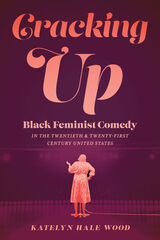 Cracking Up: Black Feminist Comedy in the Twentieth and Twenty-First Century United States
Katelyn Hale Wood
University of Iowa Press, 2021 Cracking Up archives and analyzes Black feminist stand-up comedy in the United States over the past sixty years. Looking closely at the work of Jackie “Moms” Mabley, Mo’Nique, Wanda Sykes, Sasheer Zamata, Sam Jay, Phoebe Robinson, Jessica Williams, Amanda Seales, and Michelle Buteau, this book shows how Black feminist comedy and the laughter it ignites are vital components of feminist, queer, and anti-racist protest.
Katelyn Hale Wood interprets these artists not as tokens in a white, male-dominated field, but as part of a continuous history of Black feminist performance and presence. Broadly, Cracking Up frames stand-up comedy as an important platform from which to examine citizenship in the United States, articulate Black feminist political thought, and subvert structures of power. Wood also champions comedic performance and theatre history as imperative contexts for advancing historical studies of race, gender, and sexuality. From the comedy routines popular on Black vaudeville circuits to stand-up on contemporary social media platforms, Cracking Up excavates an overlooked history of Black women who have made the art of joke-telling a key part of radical performance and political engagement.
The Cracks Between What We Are and What We Are Supposed to Be: Essays and Interviews
Harryette Mullen
University of Alabama Press, 2012 The Cracks Between What We Are and What We Are Supposed to Be forms an extended consideration not only of Harryette Mullen’s own work, methods, and interests as a poet, but also of issues of central importance to African American poetry and language, women’s voices, and the future of poetry. Together, these essays and interviews highlight the impulses and influences that drive Mullen’s work as a poet and thinker, and suggest unique possibilities for the future of poetic language and its role as an instrument of identity and power.
Cracks in the Invisible: Poems
Stephen Kampa
Ohio University Press, 2011 Stephen Kampa’s poems are witty and restless in their pursuit of an intelligent modern faith. They range from a four-line satire of office inspirational posters to a lengthy meditation on the silence of God. The poems also revel in the prosodic possibilities of English’shigh and low registers: a twenty–one line homageto Lord Byron that turns on three rhymes (one of which is “eisegesis”); a sestina whose end words include “sentimental,” “Marseilles,” and “Martian;” sapphics on the death of Ray Charles; and intricately modulated stanzas on the 1931 Spanish–language movie version of Dracula. Despite the metaphysical seriousness, there is alwaysan undercurrent of stylistic levity — a panoply of puns, comic rhymes, and loving misquotations of canonical literature — that suggests comedy and tragedy are inextricably bound in human experience.
Cracks in the Iron Closet: Travels in Gay and Lesbian Russia
David Tuller
University of Chicago Press, 1997 David Tuller provides the first look into the emotional and sexual lives of Russian lesbians and gays and the pervasive influence of the state on gay life. Part travelogue, part social history, and part journalistic inquiry, the book challenges our assumptions about what it means to be gay. The book also explores key issues in Russia and Soviet life, including concepts of friendship, community, gender, love, fate, and the relationship between the public and private spheres.
"Tuller's observant reporting and personal experiences make for absorbing reading: the human comedy rendered in unexpected ways."—New Yorker
"Anyone who thinks San Francisco is the world capital of sexual polymorphism should read this book."—Adam Goodheart, Washington Post
"[This book is] is profoundly moving."—Jim Van Buskirk, San Francisco Chronicle
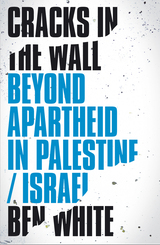 Cracks in the Wall: Beyond Apartheid in Palestine/Israel
Ben White
Pluto Press, 2018 After decades of occupation and creeping annexation, the situation on the ground in Palestine/Israel can only be described as a system of apartheid. Peace efforts have failed because of one, inconvenient truth: the Israeli maximum on offer does not meet the Palestinian minimum, or the standards of international law.
But while the situation on the ground is bleak, Ben White argues that there are widening cracks in Israel's traditional pillars of support. Opposition to Israeli policies and even critiques of Zionism are growing in Jewish communities, as well as amongst Western progressives. The election of Donald Trump has served as a catalyst for these processes, including the transformation of Israel from a partisan issue into one that divides the US establishment. Meanwhile, the Palestinian-led boycott campaign is gathering momentum, prompting a desperate backlash by Israel and its allies.
With sharp analysis, Ben White says now is the time to plot a course that avoids the mistakes of the past - a way forward beyond apartheid in Palestine. The solution is not partition and ethnic separation, but equality and self-determination - for all.
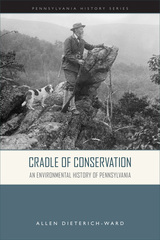 Cradle of Conservation: An Environmental History of Pennsylvania
Allen Dieterich-Ward
Temple University Press, 2024 From the origins of “Penn’s Woods” to the controversial practice of fracking, Cradle of Conservation provides the first comprehensive study of Pennsylvania’s environmental history. The story starts with forester Ralph Brock at the dawn of the conservation era and continues through the eras of energy production using coal, oil, natural gas, and other resources. Allen Dieterich-Ward also investigates how the non-human world shapes the history of the commonwealth and examines the impact of pollution.
Cradle of Conservation moves across time and place, from the Haudenosaunee people of the Susquehanna Valley, to the iron furnaces of nineteenth-century Pittsburgh, to the diesel trucks on the twentieth-century Pennsylvania Turnpike. In addition, Dieterich-Ward explores the histories of Philadelphia’s Schuylkill River and the state’s anthracite region and traces the environmental movements and crises that have led to public policy changes in the face of climate change.
Cradle of Conservation deepens our understanding of how Pennsylvanians have conserved and consumed.
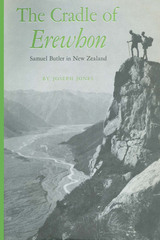 The Cradle of Erewhon: Samuel Butler in New Zealand
By Joseph Jones
University of Texas Press, 1959 In 1859, Samuel Butler, a young Cantabrigian out of joint with his family, with the church, and with the times, left England to hew out his own path in New Zealand. At the end of just five years he returned, with a modest fortune in money and an immense fortune in ideas. For out of this self-imposed exile came Erewhon, one of the world's masterpieces of satire, which contained the germ of Butler's intellectual output for the next twenty years. The Cradle of Erewhon is an examination and interpretation of the special ways in which these few crucial years affected Butler's life and work, particularly Erewhon and Erewhon Revisited. It shows us Butler the sheep farmer, explorer, and mountain climber, as well as Butler the newcomer to "The Colonies," accepting—and accepted by—his intellectual peers in the unpioneerlike little city of Christchurch, sharpening and disciplining his mind through his controversial contributions to the Christchurch Press. But more importantly, the book suggests the depth to which New Zealand penetrated the man and reveals new facets of influence hitherto unnoticed in Erewhon and Erewhon Revisited. The Southern Alps ("Oh, Wonderful! Wonderful! so lonely and so solemn"), the perilous rivers and passes, the character and customs of the Maoris—all these blend to afford new insights into a complex book. Butler was not the first to create an imaginary world as asylum from the harsh realities of this one (Vergil did the same in the Eclogues), nor was he the first, even in his own time, to protest against the machine as the enslaver of man, but his became the clearest and the freshest voice. On the biographical side, The Cradle of Erewhon offers new evidence for reappraising the man who for so long has been a psychological and literary puzzle. Why, for instance, did he repudiate his first-born book, A First Year in Canterbury Settlement? And why, once safely away from the entanglements of London, did he voluntarily return to them? Answers to these and other Butlerian riddles are suggested in the engrossing account of the satirist's sojourn in the Antipodes.
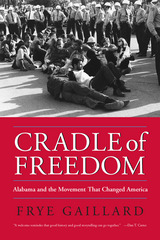 Cradle of Freedom: Alabama and the Movement That Changed America
Frye Gaillard
University of Alabama Press, 2006 Cradle of Freedom puts a human face on the story of the black American struggle for equality in Alabama during the 1960s. While exceptional leaders such as Martin Luther King Jr., Rosa Parks, Fred Shuttlesworth, Ralph Abernathy, John Lewis, and others rose up from the ranks and carved their places in history, the burden of the movement was not carried by them alone. It was fueled by the commitment and hard work of thousands of everyday people who decided that the time had come to take a stand. Cradle of Freedom is tied to the chronology of pivotal events occurring in Alabama the Montgomery bus boycott, the Freedom Rides, the Letter from the Birmingham Jail, the bombing of the 16th Street Baptist Church, Bloody Sunday, and the Black Power movement in the Black Belt. Gaillard artfully interweaves fresh stories of ordinary people with the familiar ones of the civil rights icons. We learn about the ministers and lawyers, both black and white, who aided the movement in distinct ways at key points. We meet Vernon Johns, King's predecessor at the Dexter Avenue Baptist Church in Montgomery, who first suggested boycotting the buses and who wrote later, "It is a heart strangely un-Christian that cannot thrill with joy when the least of men begin to pull in the direction of the stars." We hear from John Hulett who tells how terror of lynching forced him down into ditches whenever headlights appeared on a night road. We see the Edmund Pettus Bridge beatings from the perspective of marcher JoAnne Bland, who was only a child at the time. We learn of E. D. Nixon, a Pullman porter who helped organize the bus boycott and who later choked with emotion when, for the first time in his life, a white man extended his hand in greeting to him on a public street. How these ordinary people rose to the challenges of an unfair system with a will and determination that changed their times forever is a fascinating and extraordinary story that Gaillard tells with his hallmark talent. Cradle of Freedom unfolds with the dramatic flow of a novel, yet it is based on meticulous research. With authority and grace, Gaillard explains how the southern state deemed the Cradle of the Confederacy became with great struggle, some loss, and much hope the Cradle of Freedom.
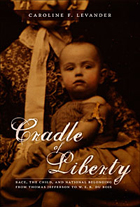 Cradle of Liberty: Race, the Child, and National Belonging from Thomas Jefferson to W. E. B. Du Bois
Caroline F. Levander
Duke University Press, 2006 Throughout American literature, the figure of the child is often represented in opposition to the adult. In Cradle of Liberty Caroline F. Levander proposes that this opposition is crucial to American political thought and the literary cultures that surround and help produce it. Levander argues that from the late eighteenth century through the early twentieth, American literary and political texts did more than include child subjects: they depended on them to represent, naturalize, and, at times, attempt to reconfigure the ground rules of U.S. national belonging. She demonstrates how, as the modern nation-state and the modern concept of the child (as someone fundamentally different from the adult) emerged in tandem from the late eighteenth century forward, the child and the nation-state became intertwined. The child came to represent nationalism, nation-building, and the intrinsic connection between nationalism and race that was instrumental in creating a culture of white supremacy in the United States. Reading texts by John Adams, Thomas Paine, Harriet Beecher Stowe, Augusta J. Evans, Mark Twain, Pauline Hopkins, William James, José Martí, W. E. B. Du Bois, and others, Levander traces the child as it figures in writing about several defining events for the United States. Among these are the Revolutionary War, the U.S.-Mexican War, the Civil War, and the U.S. expulsion of Spain from the Caribbean and Cuba. She charts how the child crystallized the concept of self—a self who could affiliate with the nation—in the early national period, and then follows the child through the rise of a school of American psychology and the period of imperialism. Demonstrating that textual representations of the child have been a potent force in shaping public opinion about race, slavery, exceptionalism, and imperialism, Cradle of Liberty shows how a powerful racial logic pervades structures of liberal democracy in the United States.
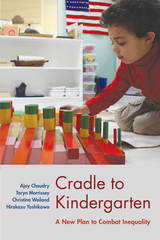 Cradle to Kindergarten: A New Plan to Combat Inequality
Ajay Chaudry
Russell Sage Foundation, 2017 Early care and education for many children in the United States is in crisis. The period between birth and kindergarten is a critical time for child development, and socioeconomic disparities that begin early in children’s lives contribute to starkly different long-term outcomes for adults. Yet, compared to other advanced economies, high-quality child care and preschool in the United States are scarce and prohibitively expensive for many middle-class and most disadvantaged families. To what extent can early-life interventions provide these children with the opportunities that their affluent peers enjoy and contribute to reduced social inequality in the long term? Cradle to Kindergarten offers a comprehensive, evidence-based strategy that diagnoses the obstacles to accessible early education and charts a path to opportunity for all children.
The U.S. government invests less in children under the age of five than do most other developed nations. Most working families must seek private childcare, which means that children from low-income households, who would benefit most from high-quality early education, are the least likely to attend them. Existing policies, such as pre-kindergarten in some states are only partial solutions. To address these deficiencies, the authors propose to overhaul the early care system, beginning with a federal paid parental leave policy that provides both mothers and fathers with time and financial support after the birth of a child. They also advocate increased public benefits, including an expansion of the child care tax credit, and a new child care assurance program that subsidizes the cost of early care for low- and moderate-income families. They also propose that universal, high-quality early education in the states should start by age three, and a reform of the Head Start program that would include more intensive services for families living in areas of concentrated poverty and experiencing multiple adversities from the earliest point in these most disadvantaged children’s lives. They conclude with an implementation plan and contend that these reforms are attainable within a ten-year timeline.
Reducing educational and economic inequalities requires that all children have robust opportunities to learn, fully develop their capacities, and have a fair shot at success. Cradle to Kindergarten presents a blueprint for fulfilling this promise by expanding access to educational and financial resources at a critical stage of child development.
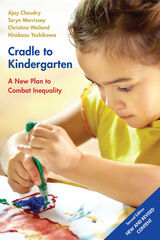 Cradle to Kindergarten: A New Plan to Combat Inequality
Ajay Chaudry
Russell Sage Foundation, 2021 Early care and education in the United States is in crisis. The period between birth and kindergarten is a crucial time for a child’s development. Yet vast racial, ethnic, and socioeconomic disparities that begin early in children’s lives contribute to starkly different long-term outcomes for adults. Compared to other advanced economies, child care and preschool in the U.S. are scarce, prohibitively expensive, and inadequate in quality for most middle- and low-income families. To what extent can early-life opportunities provide these children with the same life chances of their affluent peers and contribute to reduced social inequality in the long term, and across generations? The updated second edition of Cradle to Kindergarten offers a comprehensive, evidence-based strategy that diagnoses the obstacles to accessible early education and charts a path to opportunity for all children.
The U.S. government invests less in children under the age of five than do most other developed nations. Most working families must seek private child care, but high-quality child care options are expensive relative to the means of most families. This means that children from lower-income households, who would benefit most from high-quality early education, are the least likely to attend them. Existing policies, such as pre-kindergarten in some states, are only partial solutions, and what exists varies tremendously in terms of access and quality.
To address these deficiencies, the authors propose to overhaul the early care and education system, beginning with a federal paid parental leave policy that provides both mothers and fathers with time and financial support after the birth of a child. They also advance an expansion of the child care tax credit, and a new child care assurance program that provides grant assistance towards the cost of high-quality early care for low- and moderate-income families. Their plan establishes universal, high-quality early education in the states starting by age three, and a reform of the Head Start program that would include more intensive services for families living in areas of concentrated poverty and experiencing multiple adversities from the earliest point in these most disadvantaged children’s lives. They conclude with an implementation plan and contend that these reforms are attainable well within a ten-year timeline.
Reducing educational and economic inequalities requires that all children have robust opportunities to learn and fully develop their capacities and have a fair shot at success. Cradle to Kindergarten presents a blueprint for fulfilling this promise by expanding access to educational and financial resources at a critical stage of child development.
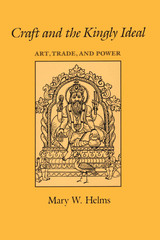 Craft and the Kingly Ideal: Art, Trade, and Power
By Mary W. Helms
University of Texas Press, 1993 In ancient Mediterranean cultures, diamonds were thought to endow their owners with invincibility. In contemporary United States culture, a foreign-made luxury car is believed to give its owner status and prestige. Where do these beliefs come from? In this study of craft production and long-distance trade in traditional, nonindustrial societies, Mary W. Helms explores the power attributed to objects that either are produced by skilled artisans and/or come from "afar." She argues that fine artisanship and long-distance trade, both of which are more available to powerful elites than to ordinary people, are means of creating or acquiring tangible objects that embody intangible powers and energies from the cosmological realms of gods, ancestors, or heroes. Through the objects, these qualities become available to human society and confer honor and power on their possessors. Helms’ novel approach equates trade with artistry and emphasizes acquisition rather than distribution. She rejects the classic Western separation between economics and aesthetics and offers a new paradigm for understanding traditional societies that will be of interest to all anthropologists and archaeologists.
Craft Beer Culture and Modern Medievalism: Brewing Dissent
Noëlle Phillips
Arc Humanities Press, 2020 <div>In recent years craft beer marketing has increasingly evoked the medieval past in orderto appeal to our collective sense of a lost community. This book discusses thedesire for the local, the non-corporate, and the pre-modern in the discourse ofcraft brewing, forming a strong counter-cultural narrative. However, suchdiscourses also reinforce colonial histories of purity and conquest whileeffacing indigenous voices. This book reveals that craft beer is therefore muchmore than a delicious adult beverage; its marketing reveals a cultural desirefor a past that has disappeared in a world that privileges the present.</div>
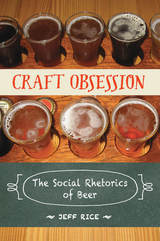 Craft Obsession: The Social Rhetorics of Beer
Jeff Rice
Southern Illinois University Press, 2016 Denied access to traditional advertising platforms by lack of resources, craft breweries have proliferated despite these challenges by embracing social media platforms, and by creating an obsessed culture of fans. In Craft Obsession, Jeff Rice uses craft beer as a case study to demonstrate how social media platforms such as Facebook and Twitter function to shape stories about craft.
Rice weaves together theories of writing, narrative, new media, and rhetoric with a personal story of his passion for craft beer. He identifies six key elements of social media rhetoric—anecdotes, repetition, aggregation, delivery, sharing, and imagery—and examines how each helps to transform small, personal experiences with craft into a more widespread movement. When shared via social media, craft anecdotes—such as the first time one had a beer—interrupt and repeat one another, building a sense of familiarity and identity among otherwise unconnected people. Aggregation, the practice of joining unlike items into one space, builds on this network identity, establishing a connection to particular brands or locations, both real and virtual. The public releases of craft beers are used to explore the concept of craft delivery, which involves multiple actors across multiple spaces and results in multiple meanings. Finally, Rice highlights how personal sharing operates within the community of craft beer enthusiasts, who share online images of acquiring, trading for, and consuming a wide variety of beers. These shared stories and images, while personal for each individual, reflect the dependence of craft on systems of involvement. Throughout, Rice relates and reflects on his own experience as a craft beer enthusiast and his participation via social media in these systems.
Both an objective scholarly study and an engaging personal narrative about craft beer, Craft Obsession provides valuable insights into digital writing, storytelling, and social media.
The Craft of History and the Study of the New Testament
Beth M. Sheppard
SBL Press, 2012 Do professional historians and New Testament scholars use the same methods to explore the past? This interdisciplinary textbook introduces students of the New Testament to the vocabulary and methods employed by historians. It discusses various approaches to historiography and demonstrates their applicability for interpreting the New Testament text and exploring its background. Overviews of the philosophy of history, common historical fallacies, and the basics of historiography are followed by three exegetical studies that illustrate the applicability of various historical methods for New Testament interpretation.
 The Craft of Indo-Arabic Numerals: How Practical Arithmetic Shaped Commerce and Mathematics in Western Europe, 1200–1600
Raffaele Danna
Harvard University Press An illuminating, fine-grained account of how Indo-Arabic numerals facilitated the spread of practical knowledge in Western Europe—reshaping both commerce and mathematics in the process.
In the thirteenth-century Mediterranean, commerce transformed as merchants shifted from Roman to Indo-Arabic numerals—an alternative that better facilitated complex calculations. It has long been known that this transition stemmed from Europe’s increasing exchanges with India, Persia, and the Arabic world. Yet much remains to be understood about how Indo-Arabic numerals—and the practical arithmetic they enabled—actually spread across Europe. As Raffaele Danna shows, it was hundreds of ordinary merchants, schoolmasters, and artisans who nurtured these changes, thereby driving key advances in both commerce and mathematics.
Drawing on an original catalogue of more than 1,200 practical arithmetic manuals, Danna charts the incremental spread of the new figures with unprecedented precision. While Italian merchants were the early adopters, it took nearly three centuries for Indo-Arabic numerals to become established in northern Europe. As Danna shows, adoption did not follow the routes of maritime trade. Rather, Indo-Arabic numerals moved gradually across the continent through inland networks of practitioners. Everywhere they went, the ten figures enhanced commercial practices and facilitated the emergence of a coherent language of mathematical craft. The growing social circulation of this knowledge, in turn, had a lasting impact on the economic trajectory of Western Europe. By the late sixteenth century, even academics were absorbing lessons from the vernacular tradition—a development that led to the first major breakthroughs in European mathematical theory since antiquity.
Combining economic history with the social history of mathematics, The Craft of Indo-Arabic Numerals illuminates the integral role of practical arithmetic in both intellectual and commercial transformations across Western Europe.
The Craft of Ivory: Sources, Techniques, and Uses in the Mediterranean World
Anthony Cutler
Harvard University Press This booklet is an examination of the nature of ivory, both as substance of certain consistent characteristics as well as material of varying availability treated by craftsmen in various and peculiar ways. The framework of this approach is defined by the geographical and chronological limits of the ivories at Dumbarton Oaks.
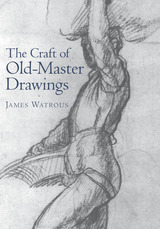 Craft of Old-Master Drawings
James Watrous
University of Wisconsin Press, 1967 A comprehensive study of the techniques of drawing, this is both a historical work, covering the period from the late Middle Ages to the present, and a useful manual for contemporary artists. It presents the old masters’ techniques by means of a thorough study of the historical and written evidence of the tools and materials used. The author also includes a series of workshop procedures he has developed with which the contemporary artist may produce the equivalents of the techniques of earlier draughtsmen. This book comprises a body of knowledge that is essential to students of art history, curators, collectors and artists, and is a significant addition to the literature on drawing.
In addition to his scholarly investigation of earlier practices, the author identifies materials and processes used by such important artists as Rembrandt, Van Gogh, Romney, Picasso, Michelangelo, Watteau, Holbein, Tiepolo, and Delacroix. For the artist interested in reproducing the effects achieved by these and many other acknowledged masters, there are full discussions and specific directions concerning the making of inks, styluses, reed and quill pens, fabricated chalks, and instructions for preparing grounds for metalpoint drawings. At every step, the discussion is supplemented with illustrations from laboratory experiments and from drawings by both old and contemporary artists. Of the more than sixty illustrations included, thirty-six are reproductions of master works, and among the others there are microphotographic enlargements of detail showing the differences in density and texture produced by various tools on different papers or grounds. Thus, as a collection of master drawings, the book is worthy of the art lover’s library; as a technical study, it is an indispensable aid to the art student and practicing artist.
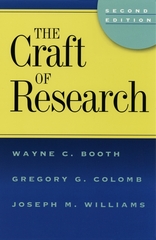 The Craft of Research
Wayne C. Booth, Gregory G. Colomb, and Joseph M. Williams
University of Chicago Press, 1995 This manual offers practical advice on the fundamentals of research to college and university students in all fields of study. The Craft of Research teaches much more than the mechanics of fact gathering: it explains how to approach a research project as an analytical process. The authors chart every stage of research, from finding a topic and generating research questions about it to marshalling evidence, constructing arguments, and writing everything up in a final report that is a model of authority. Their advice is designed for use by both beginners and seasoned practitioners, and for projects from class papers to dissertations.
This book is organized into four parts. Part One is a spirited introduction to the distinctive nature, values, and protocols of research. Part Two demystifies the art of discovering a topic. It outlines a wide range of sources, among them personal interests and passions. Parts Three and Four cover the essentials of argument—how to make a claim and support it—and ways to outline, draft, revise, rewrite, and polish the final report. Part Three is a short course in the logic, structure, uses, and common pitfalls of argumentation. The writing chapters in Part Four show how to present verbal and visual information effectively and how to shape sentences and paragraphs that communicate with power and precision.
"A well-constructed, articulate reminder of how important fundamental questions of style and approach, such as clarity and precision, are to all research."—Times Literary Supplement
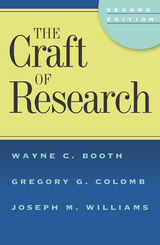 The Craft of Research, 2nd edition
Wayne C. Booth, Gregory G. Colomb, and Joseph M. Williams
University of Chicago Press, 2003 Since 1995, more than 150,000 students and researchers have turned to The Craft of Research for clear and helpful guidance on how to conduct research and report it effectively . Now, master teachers Wayne C. Booth, Gregory G. Colomb, and Joseph M. Williams present a completely revised and updated version of their classic handbook.
Like its predecessor, this new edition reflects the way researchers actually work: in a complex circuit of thinking, writing, revising, and rethinking. It shows how each part of this process influences the others and how a successful research report is an orchestrated conversation between a researcher and a reader. Along with many other topics, The Craft of Research explains how to build an argument that motivates readers to accept a claim; how to anticipate the reservations of thoughtful yet critical readers and to respond to them appropriately; and how to create introductions and conclusions that answer that most demanding question, "So what?"
Celebrated by reviewers for its logic and clarity, this popular book retains its five-part structure. Part 1 provides an orientation to the research process and begins the discussion of what motivates researchers and their readers. Part 2 focuses on finding a topic, planning the project, and locating appropriate sources. This section is brought up to date with new information on the role of the Internet in research, including how to find and evaluate sources, avoid their misuse, and test their reliability.
Part 3 explains the art of making an argument and supporting it. The authors have extensively revised this section to present the structure of an argument in clearer and more accessible terms than in the first edition. New distinctions are made among reasons, evidence, and reports of evidence. The concepts of qualifications and rebuttals are recast as acknowledgment and response. Part 4 covers drafting and revising, and offers new information on the visual representation of data. Part 5 concludes the book with an updated discussion of the ethics of research, as well as an expanded bibliography that includes many electronic sources.
The new edition retains the accessibility, insights, and directness that have made The Craft of Research an indispensable guide for anyone doing research, from students in high school through advanced graduate study to businesspeople and government employees. The authors demonstrate convincingly that researching and reporting skills can be learned and used by all who undertake research projects.
New to this edition:
Extensive coverage of how to do research on the internet, including how to evaluate and test the reliability of sources
New information on the visual representation of data
Expanded bibliography with many electronic sources
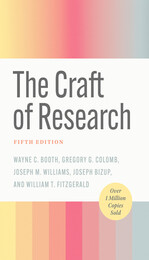 The Craft of Research, Fifth Edition
Wayne C. Booth, Gregory G. Colomb, Joseph M. Williams, Joseph Bizup, and William T. FitzGerald
University of Chicago Press, 2024 A thoroughly updated edition of a beloved classic that has guided generations of researchers in conducting effective and meaningful research.
With more than a million copies sold since its first publication, The Craft of Research has helped generations of researchers at every level—from high-school students and first-year undergraduates to advanced graduate students to researchers in business and government. Conceived by seasoned researchers and educators Wayne C. Booth, Gregory G. Colomb, and Joseph M. Williams, this fundamental work explains how to choose significant topics, pose genuine and productive questions, find and evaluate sources, build sound and compelling arguments, and convey those arguments effectively to others.
While preserving the book’s proven approach to the research process, as well as its general structure and accessible voice, this new edition acknowledges the many ways research is conducted and communicated today. Thoroughly revised by Joseph Bizup and William T. FitzGerald, it recognizes that research may lead to a product other than a paper—or no product at all—and includes a new chapter about effective presentations. It features fresh examples from a variety of fields that will appeal to today’s students and other readers. It also accounts for new technologies used in research and offers basic guidelines for the appropriate use of generative AI. And it ends with an expanded chapter on ethics that addresses researchers’ broader obligations to their research communities and audiences as well as systemic questions about ethical research practices.
This new edition will be welcomed by a new and more diverse generation of researchers.
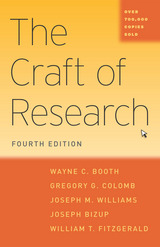 The Craft of Research, Fourth Edition
Wayne C. Booth, Gregory G. Colomb, Joseph M. Williams, Joseph Bizup and William T. FitzGerald
University of Chicago Press, 2016 A newly updated Fifth Edition of The Craft of Research has just been published under the ISBN 9780226826677. You can find it through search on this site or at any retailer.
With more than three-quarters of a million copies sold since its first publication, The Craft of Research has helped generations of researchers at every level—from first-year undergraduates to advanced graduate students to research reporters in business and government—learn how to conduct effective and meaningful research. Conceived by seasoned researchers and educators Wayne C. Booth, Gregory G. Colomb, and Joseph M. Williams, this fundamental work explains how to find and evaluate sources, anticipate and respond to reader reservations, and integrate these pieces into an argument that stands up to reader critique.
The fourth edition has been thoroughly but respectfully revised by Joseph Bizup and William T. FitzGerald. It retains the original five-part structure, as well as the sound advice of earlier editions, but reflects the way research and writing are taught and practiced today. Its chapters on finding and engaging sources now incorporate recent developments in library and Internet research, emphasizing new techniques made possible by online databases and search engines. Bizup and FitzGerald provide fresh examples and standardized terminology to clarify concepts like argument, warrant, and problem.
Following the same guiding principle as earlier editions—that the skills of doing and reporting research are not just for elite students but for everyone—this new edition retains the accessible voice and direct approach that have made The Craft of Research a leader in the field of research reference. With updated examples and information on evaluation and using contemporary sources, this beloved classic is ready for the next generation of researchers.
- Over 700,000 copies sold
- Every step of the academic research process, from the “why” of research through forming the research question, formulating an argument, and revision
- Helpful chapters on research ethics, formulation of writing assignments for teachers, and an appendix of research tools for both off and online
- Clear advice on building a strong argument in an age of false claims
- Careful attention to both the how and why of objective research-based writing
- Easy to follow, time-tested advice
- A must-have for any college or graduate student
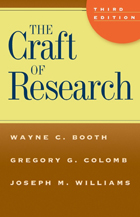 The Craft of Research, Third Edition
Wayne C. Booth, Gregory G. Colomb, and Joseph M. Williams
University of Chicago Press, 2008
With more than 400,000 copies now in print, The Craft of Research is the unrivaled resource for researchers at every level, from first-year undergraduates to research reporters at corporations and government offices.
Seasoned researchers and educators Gregory G. Colomb and Joseph M. Williams present an updated third edition of their classic handbook, whose first and second editions were written in collaboration with the late Wayne C. Booth. The Craft of Research explains how to build an argument that motivates readers to accept a claim; how to anticipate the reservations of readers and to respond to them appropriately; and how to create introductions and conclusions that answer that most demanding question, “So what?”
The third edition includes an expanded discussion of the essential early stages of a research task: planning and drafting a paper. The authors have revised and fully updated their section on electronic research, emphasizing the need to distinguish between trustworthy sources (such as those found in libraries) and less reliable sources found with a quick Web search. A chapter on warrants has also been thoroughly reviewed to make this difficult subject easier for researchers
Throughout, the authors have preserved the amiable tone, the reliable voice, and the sense of directness that have made this book indispensable for anyone undertaking a research project.
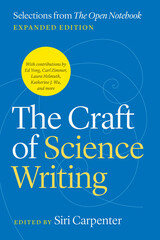 The Craft of Science Writing: Selections from “The Open Notebook,” Expanded Edition
Edited by Siri Carpenter
University of Chicago Press, 2024 A deeply sourced, inclusive guide to all aspects of science writing with contributions from some of the most skilled and award-winning authors working today.
Science writing has never been so critical to our world, and the demands on writers have never been greater. On any given day, a writer might need to explain the details of AI, analyze developments in climate change research, or serve as a watchdog helping to ensure the integrity of the scientific enterprise. At the same time, writers must spin tales that hook and keep readers, despite the endless other demands on their attention. How does one do it? The Craft of Science Writing is the authoritative guide.
With pieces curated from the archives of science writers’ go-to online resource, The Open Notebook, this book explores strategies for finding and shaping story ideas, pitching editors, and building a specialty in science writing. It delves into fundamental skills that every science writer must learn, including planning their reporting; identifying, interviewing, and quoting sources; organizing interview notes; and crafting stories that engage and inform audiences. This expanded edition includes new introductory material and nine new essays focusing on such topics as how to establish a science beat, how to find and use quotes, how to critically evaluate scientific claims, how to use social media for reporting, and how to do data-driven reporting. In addition, there are essays on inclusivity in science writing, offering strategies for eradicating ableist language from stories, working with sensitivity readers, and breaking into English-language media for speakers of other languages.
Through interviews with leading journalists offering behind-the-scenes inspiration as well as in-depth essays on the craft offering practical advice, readers will learn how the best science stories get made, from conception to completion.
Contributors:
Humberto Basilio, Siri Carpenter, Jeanne Erdmann, Dan Ferber, Tina Casagrand Foss, Geoffrey Giller, Laura Helmuth, Jane C. Hu, Alla Katsnelson, Roxanne Khamsi, Betsy Ladyzhets, Jyoti Madhusoodanan, Amanda Mascarelli, Robin Meadows, Kate Morgan, Tiên Nguyễn, Michelle Nijhuis, Aneri Pattani, Rodrigo Pérez Ortega, Mallory Pickett, Kendall Powell, Tasneem Raja, Sandeep Ravindran, Marion Renault, Julia Rosen, Megha Satyanarayana, Christina Selby, Knvul Sheikh, Abdullahi Tsanni, Alexandra Witze, Katherine J. Wu, Wudan Yan, Ed Yong, Rachel Zamzow, Sarah Zhang, and Carl Zimmer
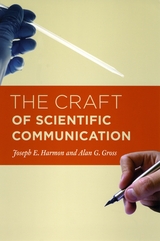 The Craft of Scientific Communication
Joseph E. Harmon and Alan G. Gross
University of Chicago Press, 2010 The ability to communicate in print and person is essential to the life of a successful scientist. But since writing is often secondary in scientific education and teaching, there remains a significant need for guides that teach scientists how best to convey their research to general and professional audiences. The Craft of Scientific Communication will teach science students and scientists alike how to improve the clarity, cogency, and communicative power of their words and images. In this remarkable guide, Joseph E. Harmon and Alan G. Gross have combined their many years of experience in the art of science writing to analyze published examples of how the best scientists communicate. Organized topically with information on the structural elements and the style of scientific communications, each chapter draws on models of past successes and failures to show students and practitioners how best to negotiate the world of print, online publication, and oral presentation.
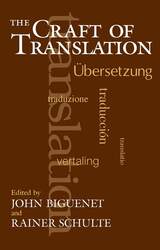 The Craft of Translation
Edited by John Biguenet and Rainer Schulte
University of Chicago Press, 1989 Written by some of the most distinguished literary translators working in English today, these essays offer new and uncommon insights into the understanding and craft of translation. The contributors not only describe the complexity of translating literature but also suggest the implications of the act of translation for critics, scholars, teachers, and students. The demands of translation, according to these writers, require both comprehensive scholarship in preparing to translate a text and broad creativity in recreating the text in a new language. Translation, thus, becomes a model for the most exacting reading and the most serious scholarship.
Some of the contributors lay bare the rigorous methods of literary translation in comparisons of various translations of the same piece; some discuss the problems of translating a specific passage; others speak about the lessons learned over the course of a career in translation. As these essays make clear, translators work in the space between languages and, in so doing, provide insights into the ways in which a culture makes the world verbal. Exemplary readers both of authors and of their individual works, the translators represented in this collection demonstrate that the methodologies derived from the art and craft of translation can serve as a model to revitalize the interpretation and understanding of literary works.
Readers will find the opportunity to look over the shoulders of the translators gathered together in this volume an exciting and surprising experience. The act of translation emerges both as a powerful integration of linguistic, semantic, cultural, and historical thinking and as a valuable commentary on how we communicate both within a culture and from one culture to another.
The Craft of Zeus: Myths of Weaving and Fabric
John Scheid and Jesper Svenbro
Harvard University Press, 1996 The fundamental gesture of weaving in The Craft of Zeus is the interlacing of warp and woof described by Plato in The Statesman—an interweaving signifying the union of opposites. From rituals symbolizing—even fabricating—the cohesion of society to those proposed by oracles as a means of propitiating fortune; from the erotic and marital significance of weaving and the woven robe to the use of weaving as a figure for language and the fabric of the text, this lively and lucid book defines the logic of one of the central concepts in Greek and Roman thought—a concept that has persisted, woof and warp crossing again and again, as the fabric of human history has unfolded.
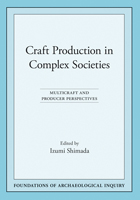 Craft Production in Complex Societies: Multicraft and Producer Perspectives
Izumi Shimada
University of Utah Press, 2007 The study of craft production is a complex and challenging one that illuminates key aspects of the material, organizational, and ideological interests, values, and capacities of a given culture.
Many crafts are treated as separate, but are actually practiced concurrently and in close proximity to each other, facilitating crucial interaction. There is a need for a balanced evaluation of the roles of producer and consumer in craft production, and the importance of properly contextualized workshop excavations and the definition of the entire sequence of operation in documenting craft production both as a social and material process.
Craft Production in Complex Societies redresses the skewed conception and approach to craft production that have been shaped by studies focused on separate, single medium crafts, finished products, and the consumer. It presents case studies and regional syntheses from diverse geographical areas, time periods, and sociopolitical complexities that break important new ground in the anthropological study of the creative role and social identity of the producer and multi-craft production. It is expected to serve as a key reference in craft studies for many years to come.
 Crafting a Cloning Policy: From Dolly to Stem Cells
Andrea L. Bonnicksen
Georgetown University Press, 2002 Ever since Dolly, the Scottish lamb, tottered on wobbly legs into our consciousness-followed swiftly by other animals: first, mice; then pigs that may provide human transplants, and even an ordinary house cat-thoughts have flown to the cloning of human beings. Legislators rushed to propose a ban on a technique that remains highly hypothetical, although some independent researchers have announced their determination to pursue the possibilities. Political scientist and well-known expert on reproductive issues, Andrea L. Bonnicksen examines the political reaction to this new-born science and the efforts to construct cloning policy. She also looks at issues that relate to stem cell research, its even newer sibling, and poses a key question: How does the response to Dolly guide us as we manage innovative reproductive technologies in the future? Various legislative endeavors and the efforts by the Food and Drug Administration (FDA) to oversee cloning, as well as policy models related to federal funding, individual state laws, and programs abroad, inform Bonnicksen's identification of four types of cloning policy. She analyzes in depth the roles of diverse interest groups as each struggle to become the dominant voice in the decision-making process. With skill and insight, she clears the mists from a complicated topic, and addresses the legal, political, and ethical arguments that are not likely to disappear from the national conversation or debates any time soon.
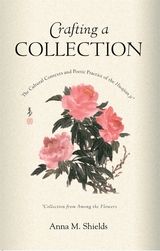 Crafting a Collection: The Cultural Contexts and Poetic Practice of the Huajian ji (Collection from Among the Flowers)
Anna M. Shields
Harvard University Press, 2006 Compiled in 940 at the court of the kingdom of Shu, the Huajian ji is the earliest extant collection of song lyrics by literati poets. The collection has traditionally been studied as the precursor to the lyrics of the Song dynasty, or in terms of what it contributed to the later development of the genre. But scholars have rarely examined the work as an anthology, and have more often focused on the work of individual poets and their respective contributions to the genre.
In this book, Anna Shields examines the influence of court culture on the creation of the anthology and the significance of imitation and convention in its lyrics. Shields suggests that by considering the Huajian ji only in terms of its contributions to a later "model," we unnecessarily limit ourselves to a single literary form, and risk overlooking the broader influence of Tang culture on the Huajian ji. By illuminating the historical and literary contexts of the anthology, the author aims to situate the Huajian ji within larger questions of Chinese literary history, particularly the influence of cultural forces on the emergence of genres and the development of romantic literature.
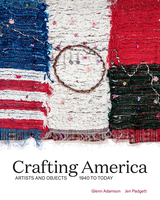 Crafting America: Artists and Objects, 1940 to Today
Jen Padgett
University of Arkansas Press, 2020 Craft is a diverse, democratic art form practiced by Americans of every gender, age, ethnicity, and class. Crafting America traces this expansive range of skilled making in a variety of forms, from ceramics and wood to performance costume and community-based practice. In exploring the intertwining of craft and American experience, this volume reveals how artists leverage their craft to realize the values of life, liberty, and the pursuit of happiness. Accompanying an exhibition of the same title organized by Crystal Bridges Museum of American Art, Crafting America features contributions from scholars that illuminate craft’s relationship to ritual and memory, personal independence, abstraction, and Native American histories. The richly illustrated catalog section—with more than a hundred color images accompanied by lively commentary—presents a vivid picture of American craft over the past eight decades, offering fresh insights on the relationships between objects. Building upon recent advances in craft scholarship and encouraging more inclusive narratives, Crafting America presents a bold statement on the vital role of craft within the broader context of American art and identity.
Crafting Compositions: Tools for Today's Writers
Janet Giannotti
University of Michigan Press, 2004 Crafting Compositions guides students through the entire writing process, with exercises in planning, drafting, responding and revising, and polishing. In addition to completing free writing exercises, keeping a journal of informal responses, and revising sample compositions, students will draft, revise, and edit one composition per chapter.
The textbook features:
"Authentic readings to foster vocabulary development, show successful techniques, and serve as a jumping-off point for free writing.
"A "learning log" in which students write to practice the writing lessons and tips presented.
"A two-track system in which students simultaneously work with the writing of other students as they work on their own compositions.
"Toolbox mini-lessons to review common grammar trouble spots.
This mid-level writing text is appropriate for high school, community college, or university course
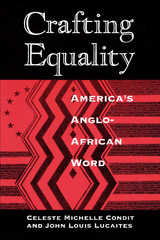 Crafting Equality: America's Anglo-African Word
Celeste Michelle Condit and John Louis Lucaites
University of Chicago Press, 1993 Philosophers and historians often treat fundamental concepts like equality as if they existed only as fixed ideas found solely in the canonical texts of civilization. In Crafting Equality, Celeste Michelle Condit and John Louis Lucaites argue that the meaning of at least one key word—equality—has been forged in the day-to-day pragmatics of public discourse.
Drawing upon little studied speeches, newspapers, magazines, and other public discourse, Condit and Lucaites survey the shifting meaning of equality from 1760 to the present as a process of interaction and negotiation among different social groups in American politics and culture. They make a powerful case for the critical role of black Americans in actively shaping what equality has come to mean in our political conversation by chronicling the development of an African-American rhetorical community. The story they tell supports a vision of equality that embraces both heterogeneity and homogeneity as necessary for maintaining the balance between liberty and property.
A compelling revision of an important aspect of America's history, Crafting Equality will interest anyone wanting to better understand the role public discourse plays in affecting the major social and political issues of our times. It will also interest readers concerned with the relationship between politics and culture in America's increasingly multi-cultural society.
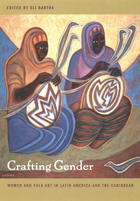 Crafting Gender: Women and Folk Art in Latin America and the Caribbean
Eli Bartra, ed.
Duke University Press, 2003 This volume initiates a gender-based framework for analyzing the folk art of Latin America and the Caribbean. Defined here broadly as the "art of the people" and as having a primarily decorative, rather than utilitarian, purpose, folk art is not solely the province of women, but folk art by women in Latin America has received little sustained attention. Crafting Gender begins to redress this gap in scholarship. From a feminist perspective, the contributors examine not only twentieth-century and contemporary art by women, but also its production, distribution, and consumption. Exploring the roles of women as artists and consumers in specific cultural contexts, they look at a range of artistic forms across Latin America, including Panamanian molas (blouses), Andean weavings, Mexican ceramics, and Mayan hipiles (dresses). Art historians, anthropologists, and sociologists from Latin America, the Caribbean, and the United States discuss artwork from Mexico, Argentina, Chile, Colombia, Ecuador, Panama, Suriname, and Puerto Rico, and many of their essays focus on indigenous artists. They highlight the complex webs of social relations from which folk art emerges. For instance, while several pieces describe the similar creative and technical processes of indigenous pottery-making communities of the Amazon and of mestiza potters in Mexico and Colombia, they also reveal the widely varying functions of the ceramics and meanings of the iconography. Integrating the social, historical, political, geographical, and economic factors that shape folk art in Latin America and the Caribbean, Crafting Gender sheds much-needed light on a rich body of art and the women who create it.
Contributors
Eli Bartra
Ronald J. Duncan
Dolores Juliano
Betty LaDuke
Lourdes Rejón Patrón
Sally Price
María de Jesús Rodríguez-Shadow
Mari Lyn Salvador
Norma Valle
Dorothea Scott Whitten
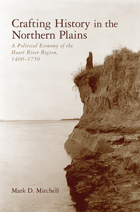 Crafting History in the Northern Plains: A Political Economy of the Heart River Region, 1400–1750
Mark D. Mitchell
University of Arizona Press, 2013 The histories of post-1500 American Indian and First Nations societies reflect a dynamic interplay of forces. Europeans introduced new technologies, new economic systems, and new social forms, but those novelties were appropriated, resisted, modified, or ignored according to indigenous meanings, relationships, and practices that originated long before Europeans came to the Americas. A comprehensive understanding of the changes colonialism wrought must therefore be rooted in trans-Columbian native histories that span the centuries before and after the advent of the colonists.
In Crafting History in the Northern Plains Mark D. Mitchell illustrates the crucial role archaeological methods and archaeological data can play in producing trans-Columbian histories. Combining an in-depth analysis of the organization of stone tool and pottery production with ethnographic and historical data, Mitchell synthesizes the social and economic histories of the native communities located at the confluence of the Heart and Missouri rivers, home for more than five centuries to the Mandan people.
Mitchell is the first researcher to examine the impact of Mandan history on the developing colonial economy of the Northern Plains. In Crafting History in the Northern Plains, he demonstrates the special importance of native history in the 1400s and 1500s to the course of European colonization.
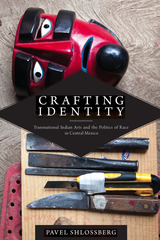 Crafting Identity: Transnational Indian Arts and the Politics of Race in Central Mexico
Pavel Shlossberg
University of Arizona Press, 2015 Crafting Identity goes far beyond folklore in its ethnographic exploration of mask making in central Mexico. In addition to examining larger theoretical issues about indigenous and mestizo identity and cultural citizenship as represented through masks and festivals, the book also examines how dominant institutions of cultural production (art, media, and tourism) mediate Mexican “arte popular,” which makes Mexican indigeneity “digestible” from the standpoint of elite and popular Mexican nationalism and American and global markets for folklore.
The first ethnographic study of its kind, the book examines how indigenous and mestizo mask makers, both popular and elite, view and contest relations of power and inequality through their craft. Using data from his interviews with mask makers, collectors, museum curators, editors, and others, Pavel Shlossberg places the artisans within the larger context of their relationships with the nation-state and Mexican elites, as well as with the production cultures that inform international arts and crafts markets. In exploring the connection of mask making to capitalism, the book examines the symbolic and material pressures brought to bear on Mexican artisans to embody and enact self-racializing stereotypes and the performance of stigmatized indigenous identities.
Shlossberg’s weaving of ethnographic data and cultural theory demystifies the way mask makers ascribe meaning to their practices and illuminates how these practices are influenced by state and cultural institutions. Demonstrating how the practice of mask making negotiates ethnoracial identity with regard to the Mexican state and the United States, Shlossberg shows how it derives meaning, value, and economic worth in the eyes of the state and cultural institutions that mediate between the mask maker and the market.
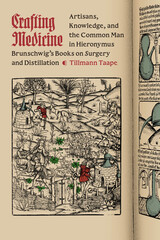 Crafting Medicine: Artisans, Knowledge, and the Common Man in Hieronymus Brunschwig's Books on Surgery and Distillation
Tillmann Taape
University of Chicago Press, 2025 How an early modern surgeon and his accessible writings changed medical expertise and the communication of medical knowledge.
Between 1497 and 1512, Hieronymus Brunschwig (ca. 1450–ca. 1530), an obscure craftsman from Strasbourg, wrote books on surgery and pharmacy that transformed medical expertise, how it was codified in print, and how it was communicated to new audiences. Brunschwig was an unlikely author. He apprenticed as a surgeon in the local guild and dispensed medicines from his own shop. But he was remarkably well-read in surgery, alchemy, and medical theory, even if he lacked a university education. His unique authorial voice spoke to the healing practices of craftsmen and common people in a down-to-earth German dialect.
Crafting Medicine, by Tillmann Taape, is the first in-depth study of Brunschwig and his works. In it, Taape argues that Brunschwig’s writings shaped a nascent tradition of vernacular medicine. Brunschwig’s books represent a key moment in the history of medical print, for they conveyed medical expertise to a new readership of nonacademic practitioners, who became a key audience for a flood of vernacular medical publications during the sixteenth century. Using Brunschwig’s books as a unique window into the past, Crafting Medicine beautifully reconstructs the world of science inhabited by Brunschwig, his fellow craftsmen, his translators, and his readers.
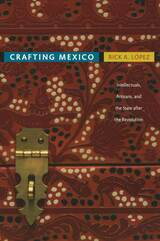 Crafting Mexico: Intellectuals, Artisans, and the State after the Revolution
Rick A. López
Duke University Press, 2010 After Mexico’s revolution of 1910–1920, intellectuals sought to forge a unified cultural nation out of the country’s diverse populace. Their efforts resulted in an “ethnicized” interpretation of Mexicanness that intentionally incorporated elements of folk and indigenous culture. In this rich history, Rick A. López explains how thinkers and artists, including the anthropologist Manuel Gamio, the composer Carlos Chávez, the educator Moisés Sáenz, the painter Diego Rivera, and many less-known figures, formulated and promoted a notion of nationhood in which previously denigrated vernacular arts—dance, music, and handicrafts such as textiles, basketry, ceramics, wooden toys, and ritual masks—came to be seen as symbolic of Mexico’s modernity and national distinctiveness. López examines how the nationalist project intersected with transnational intellectual and artistic currents, as well as how it was adapted in rural communities. He provides an in-depth account of artisanal practices in the village of Olinalá, located in the mountainous southern state of Guerrero. Since the 1920s, Olinalá has been renowned for its lacquered boxes and gourds, which have been considered to be among the “most Mexican” of the nation’s arts. Crafting Mexico illuminates the role of cultural politics and visual production in Mexico’s transformation from a regionally and culturally fragmented country into a modern nation-state with an inclusive and compelling national identity.
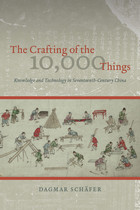 The Crafting of the 10,000 Things: Knowledge and Technology in Seventeenth-Century China
Dagmar Schäfer
University of Chicago Press, 2011 The last decades of the Ming dynasty, though plagued by chaos and destruction, saw a significant increase of publications that examined advances in knowledge and technology. Among the numerous guides and reference books that appeared during this period was a series of texts by Song Yingxing (1587–1666?), a minor local official living in southern China. His Tiangong kaiwu, the longest and most prominent of these works, documents the extraction and processing of raw materials and the manufacture of goods essential to everyday life, from yeast and wine to paper and ink to boats, carts, and firearms.
In The Crafting of the 10,000 Things, Dagmar Schäfer probes this fascinating text and the legacy of its author to shed new light on the development of scientific thinking in China, the purpose of technical writing, and its role in and effects on Chinese history. Meticulously unfolding the layers of Song’s personal and cultural life, Schäfer chronicles the factors that motivated Song to transform practical knowledge into written culture. She then examines how Song gained, assessed, and ultimately presented knowledge, and in doing so articulates this era’s approaches to rationality, truth, and belief in the study of nature and culture alike. Finally, Schäfer places Song’s efforts in conjunction with the work of other Chinese philosophers and writers, before, during, and after his time, and argues that these writings demonstrate collectively a uniquely Chinese way of authorizing technology as a legitimate field of scholarly concern and philosophical knowledge.
Offering an overview of a thousand years of scholarship, The Crafting of the 10,000 Things explains the role of technology and crafts in a culture that had an outstandingly successful tradition in this field and was a crucial influence on the technical development of Europe on the eve of the Industrial Revolution.
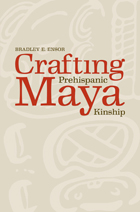 Crafting Prehispanic Maya Kinship
Bradley E. Ensor
University of Alabama Press, 2013 By contextualizing classes and their kinship behavior within the overall political economy, Crafting Prehispanic Maya Kinship provides an example of how archaeology can help to explain the formation of disparate classes and kinship patterns within an ancient state-level society. Bradley E. Ensor provides a new theoretical contribution to Maya ethnographic, ethnohistoric, and archaeological research. Rather than operating solely as a symbolic order unobservable to archaeologists, kinship, according to Ensor, forms concrete social relations that structure daily life and can be reflected in the material remains of a society. Ensor argues that the use of cross-culturally identified and confirmed material indicators of postmarital residence and descent group organization enable archaeologists—those with the most direct material evidence on prehispanic Maya social organization—to overturn a traditional reliance on competing and problematic ethnohistorical models.
Using recent data from an arch aeological project within the Chontalpa Maya region of Tabasco, Mexico, Ensor illustrates how archaeologists can interpret and explain the diversity of kinship behavior and its influence on gender within any given Maya social formation.
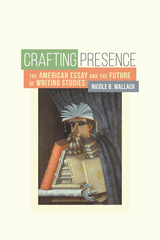 Crafting Presence: The American Essay and the Future of Writing Studies
Nicole B. Wallack
Utah State University Press, 2016 Essays are central to students’ and teachers’ development as thinkers in their fields. In Crafting Presence, Nicole B. Wallack develops an approach to teaching writing with the literary essay that holds promise for writing students, as well as for achieving a sense of common purpose currently lacking among professionals in composition, creative writing, and literature.
Wallack analyzes examples drawn primarily from volumes of The Best American Essays to illuminate the most important quality of the essay as a literary form: the writer’s “presence.” She demonstrates how accounting for presence provides a flexible and rigorous heuristic for reading the contexts, formal elements, and purposes of essays. Such readings can help students learn writing principles, practices, and skills for crafting myriad presences rather than a single voice.
Crafting Presence holds serious implications for writing pedagogy by providing new methods to help teachers and students become more insightful and confident readers and writers of essays. At a time when liberal arts education faces significant challenges, this important contribution to literary studies, composition, and creative writing shows how an essay-centered curriculum empowers students to show up in the world as public thinkers who must shape the “knowledge economy” of the twenty-first century.
 Crafting Science: A Sociohistory of the Quest for the Genetics of Cancer
Joan H. Fujimura
Harvard University Press, 1996 During the late 1970s and 1980s, "cancer" underwent a remarkable transformation. In one short decade, what had long been a set of heterogeneous diseases marked by uncontrolled cell growth became a disease of our genes. How this happened and what it means is the story Joan Fujimura tells in a rare inside look at the way science works and knowledge is created. A dramatic study of a new species of scientific revolution, this book combines a detailed ethnography of scientific thought, an in-depth account of science practiced and produced, a history of one branch of science as it entered the limelight, and a view of the impact of new genetic technologies on science and society.
The scientific enterprise that Fujimura unfolds for us is proto-oncogene cancer research--the study of those segments of DNA now thought to make normal cells cancerous. Within this framework, she describes the processes of knowledge construction as a social enterprise, an endless series of negotiations in which theories, material technologies, and practices are co-constructed, incorporated, and refashioned. Along the way, Fujimura addresses long-standing questions in the history and philosophy of science, culture theory, and sociology of science: How do scientists create "good" problems, experiments, and solutions? What are the cultural, institutional, and material technologies that have to be in place for new truths and new practices to succeed?
Portraying the development of knowledge as a multidimensional process conducted through multiple cultures, institutions, actors, objects, and practices, this book disrupts divisions among sociology, history, anthropology, and the philosophy of science, technology, and medicine.
Crafting Selves: Power, Gender, and Discourses of Identity in a Japanese Workplace
Dorinne K. Kondo
University of Chicago Press, 1990 "The ethnography of Japan is currently being reshaped by a new generation of Japanologists, and the present work certainly deserves a place in this body of literature. . . . The combination of utility with beauty makes Kondo's book required reading, for those with an interest not only in Japan but also in reflexive anthropology, women's studies, field methods, the anthropology of work, social psychology, Asian Americans, and even modern literature."—Paul H. Noguchi, American Anthropologist
"Kondo's work is significant because she goes beyond disharmony, insisting on complexity. Kondo shows that inequalities are not simply oppressive-they are meaningful ways to establish identities."—Nancy Rosenberger, Journal of Asian Studies
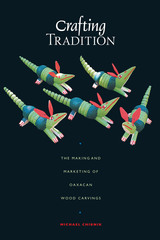 Crafting Tradition: The Making and Marketing of Oaxacan Wood Carvings
By Michael Chibnik
University of Texas Press, 2003 Since the mid-1980s, whimsical, brightly colored wood carvings from the Mexican state of Oaxaca have found their way into gift shops and private homes across the United States and Europe, as Western consumers seek to connect with the authenticity and tradition represented by indigenous folk arts. Ironically, however, the Oaxacan wood carvings are not a traditional folk art. Invented in the mid-twentieth century by non-Indian Mexican artisans for the tourist market, their appeal flows as much from intercultural miscommunication as from their intrinsic artistic merit. In this beautifully illustrated book, Michael Chibnik offers the first in-depth look at the international trade in Oaxacan wood carvings, including their history, production, marketing, and cultural representations. Drawing on interviews he conducted in the carving communities and among wholesalers, retailers, and consumers, he follows the entire production and consumption cycle, from the harvesting of copal wood to the final purchase of the finished piece. Along the way, he describes how and why this "invented tradition" has been promoted as a "Zapotec Indian" craft and explores its similarities with other local crafts with longer histories. He also fully discusses the effects on local communities of participating in the global market, concluding that the trade in Oaxacan wood carvings is an almost paradigmatic case study of globalization.
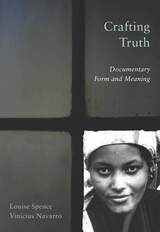 Crafting Truth: Documentary Form and Meaning
Spence, Louise
Rutgers University Press, 2011 Documentaries such as Zana Briski and Ross Kauffman's Born into Brothels, Michael Moore's Fahrenheit 9/11, Jeffrey Blitz's Spellbound, along with March of the Penguins and An Inconvenient Truth have achieved critical as well as popular success. Although nonfiction film may have captured imaginations, many viewers enter and leave theaters with a nanve concept of "truth" and "reality"-for them, documentaries are information sources. But is truth or reality readily available, easily acquired, or undisputed? Or do documentaries convey illusions of truth and reality? What aesthetic means are used to build these illusions?
A documentary's sounds and images are always the product of selection and choice, and often underscore points the filmmaker wishes to make. Crafting Truth illuminates the ways these films tell their stories; how they use the camera, editing, sound, and performance; what rhetorical devices they employ; and what the theoretical, practical, and ethical implications of these choices are. Complex documentary concepts are presented through easily accessible language, images, and a discussion of a wide range of films and videos to encourage new ways of thinking about and seeing nonfiction film.
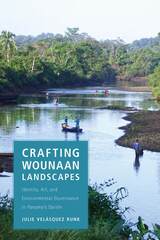 Crafting Wounaan Landscapes: Identity, Art, and Environmental Governance in Panama's Darién
Julie Velásquez Runk
University of Arizona Press, 2017 Panama’s Darién is a name many conservationists know. Renowned for its lowland tropical forests, its fame is more pronounced because a road that should be there is not: environmentalists have repeatedly, and remarkably, blocked all attempts to connect the Americas via the Pan American Highway. That lacuna, that absence of a road, also serves to occlude history in the region as its old-growth forests give the erroneous impression of a peopleless nature. In Crafting Wounaan Landscapes, Julie Velásquez Runk upends long-standing assumptions about the people that call Darién home, and she demonstrates the agency of the Wounaan people to make their living and preserve and transform their way of life in the face of continuous and tremendous change. Velásquez Runk focuses on Wounaan crafting—how their ability to subtly effect change has granted them resilience in a dynamic and globalized era. She theorizes that unpredictable landscapes, political decisions, and cultural beliefs are responsible for environmental conservation problems, and she unpacks environmental governance efforts that illustrate what happens when conservation is confronted with people in a purportedly peopleless place. The everyday dangers of environmental governance without local crafting include logging, land grabbing, and loss of carbon in a new era of carbon governance in the face of climate change. Crafting Wounaan Landscapes provides recognition of local ways of knowing and being in the world that may be key to the future of conservation practice.
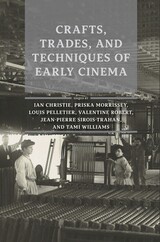 Crafts, Trades, and Techniques of Early Cinema
Ian Christie, Priska Morrissey, Louis Pelletier, Valentine Robert, Jean-Pierre Sirois-Trahan, and Tami Williams
Michigan Publishing, 2024 These proceedings of the 16th conference of the international society for the study of early cinema Domitor includes 26 studies and numerous rarely seen figures dealing with the often overlooked history of the crafts, trades and techniques of early cinema. By examining material culture and the institutionalization of practices into trades during the late 19th and early 20th centuries, this new investigation into the skills and the techniques that defined the cinema in its early decades aims to foster a better understanding of the medium in its varied industrial and professional aspects. The art and gestures of craftspersons—including performers, camera operators, editors, directors, designers, engineers, projectionists, programmers, and critics—, like those of the factory or laboratory workers, are considered for their emerging specificity, as well as in relation to existing cultural, material and technological forms. This book shows how the industrialization of cinema, the professionalization of workers, and the standardization of techniques led to the creation (or at times, subversion) of norms, and consequently legitimized certain skills, crafts and techniques at the expense of others.
The intermedial approaches deployed in this collection bring into focus the influence of multiple professional worlds and cultural practices on the nascent film medium, as well as the necessary adaptations and transformations required by the latter. This circulatory dynamic concerns people and practices, studied in a non-diffusionist approach taking into account transcultural interactions. Chapters examine the mechanisms of professionalization and identity-building as they relate to professions such as filmmaker or colorist, as well as to more unexpected occupations such as accountant, censor, or chemical engineer.
The notion of technique is broadly defined. Several of the volume’s chapters deal with cameras or special effects, as well as with new historical investigation into mysterious technical devices such as shutters, cue systems or working samples. Going beyond this preoccupation with materiality, the collected studies also approach technique as a human and cultural activity, and thus as a set of gestures, crafts, and expertise. The book more specifically opens up a reflection on the skills of screen performers and on the training that brought the institutionalization of body techniques and film acting. The book further illustrates to an unprecedented extent that the first film workers were frequently women.
Several chapters are dedicated to the unconventional careers of specific film workers, with particular attention being given to the diversity and complexity of professional trajectories. Indeed, this book demonstrates that the invention of cinema was deeply enmeshed with the rise of international networks, which resulted in the standardization of technical practices within corporate and national contexts being ultimately shaped by globalization.
Craftsmanship and the Michigan Union Carpenter
Philip A. Korth
University of Wisconsin Press, 1991 This volume celebrates the craftsmanship of Michigan Union carpenters. Retired members of the United Brotherhood of Carpenters share pride in their skill and accomplishments, through edited oral histories in this volume. Their histories convey a sense of self, a sense of dignity, and an appreciation of the significance of their work.
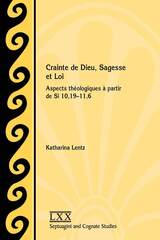 Crainte de Dieu, Sagesse et Loi: Aspects théologiques à partir de Si 10,19-11,6
Katharina Lentz
SBL Press, 2020 Peu d'études spécifiques ont été consacrées à Ben Sira 10,19-11,6. Lentz examine le texte en hébreu, grec, syriaque et latin, en essayant d'identifier les différences majeures entre ces versions et leurs orientations fondamentales respectives. Dans cette péricope, elle révèle trois thèmes importants: la crainte de Dieu, la sagesse et la loi. En prenant comme point de départ le thème de la crainte de Dieu dans le Deutéronome, les Psaumes et les Proverbes, Job et Qoheleth en plus de Ben Sira, Lentz examine la relation de ce thème avec la sagesse et la loi. La relation étroite entre la crainte de Dieu, la sagesse et la loi devrait inciter les spécialistes à se demander si celles-ci ne représentent pas trois aspects de la même réalité.
Few specific studies have been devoted to Ben Sira 10:19-11:6. Lentz examines the text in Hebrew, Greek, Syriac, and Latin, trying to identify the major differences between these versions and their respective fundamental orientations. In this pericope she reveals three important themes: the fear of God, wisdom, and the law. Taking as a point of departure the theme of the fear of God in Deuteronomy, Psalms, and Proverbs, Job, and Qoheleth, in addition to Ben Sira, Lentz examines the relationship of this theme with wisdom and the law. The close relationship between the fear of God, wisdom, and the law should lead scholars to ask if these do not represent three aspects of the same reality.
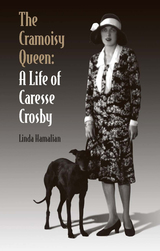 The Cramoisy Queen: A Life of Caresse Crosby
Linda Hamalian
Southern Illinois University Press, 2009 Caresse Crosby rejected the culturally prescribed roles for women of her era and background in search of an independent, creative, and socially responsible life. Poet, memoirist, advocate of women’s rights and the peace movement, Crosby published and promoted modern writers and artists such as Hart Crane, Dorothy Parker, Salvador Dalí, and Romare Bearden. She also earned a place in the world of fashion by patenting one of the earliest versions of the brassiere. Behind her public success was a chaotic life: three marriages, two divorces, the suicide of her husband Harry Crosby, strained relationships with her children, and legal confrontations over efforts to establish a center for world peace. As the first biographer to consider both the literary and social contexts of Crosby’s life, Linda Hamalian details Crosby’s professional accomplishments and her personal struggles. The Cramoisy Queen: A Life of Caresse Crosby also measures the impact of small presses on modernist literature and draws connections between key writers and artists of the era. In addition to securing a place for Crosby in modern literary and cultural history, The Cramoisy Queen: A Life of Caresse Crosby contributes to the field of textual studies, specifically the complexities of integrating autobiography and correspondence into biography. Enhanced by thirty-two illustrations, the volume appeals to a wide range of readers, including literary critics, cultural historians, biographers, and gender studies specialists.
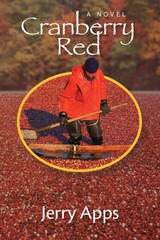 Cranberry Red: A Novel
Jerry Apps
University of Wisconsin Press, 2010
The fourth novel in Jerry Apps’s Ames County series, Cranberry Red brings the story into the present, portraying the challenges of agriculture in the twenty-first century.
As the novel opens, Ben Wesley has lost his job as agricultural agent for Ames County. He is soon hired as a research application specialist for Osborne University, a for-profit institution that has developed “Cranberry Red,” a new chemical that promises not only to improve cranberry crop yields but also to endow the fruits with the power to prevent heart disease, reduce brain damage from strokes, and ward off Alzheimer’s disease. Ben must promote the new product to cranberry growers in Ames County and beyond, but he worries whether the promised results are credible. Was Cranberry Red rushed to market?
When the chemical does all that the university claims it will do, Ben is relieved . . . until disturbing side effects emerge. Can he criticize Cranberry Red and safeguard farmers and consumers without losing his job, or will Ben’s honesty get him fired while his community continues to get sicker?
Finalist, General Fiction, Midwest Book Awards
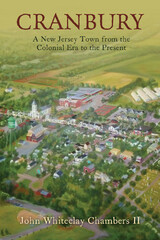 Cranbury: A New Jersey Town from the Colonial Era to the Present
Chambers, John Whiteclay
Rutgers University Press, 2012 Winner of the 2013 Award of Merit by the American Association for State and Local History Leadership in History awards committee
Winner of the 2013 New Jersey Studies Academic Alliance, Author Awards, Non-fiction Popular Category
One of the oldest towns in New Jersey, Cranbury has a long and noteworthy history that is in part distinctive and in part broadly representative of larger themes in the development of the state and the nation. In this beautifully illustrated book sponsored by Cranbury Landmarks, Inc., historian John Whiteclay Chambers II links the narrative of this remarkable place to contemporary debates about suburbanization and land-use planning. Founded in 1697 and soon featuring an inn, a gristmill, and a church, the village prospered due to its strategic location on important transportation routes between New York and Philadelphia and its fertile, productive farmland. David Brainerd, a famous and controversial young missionary, came there to preach to the Lenape Indians. In 1778, George Washington and his army stayed there on their way to the Battle of Monmouth. In the nineteenth century, roadways, railroads, and turnpikes spurred the town’s commerce and agriculture. Yet unlike many old agricultural centers transformed by suburbanization in the twentieth century, Cranbury has retained its picturesque, small-town image and much of its charm. Cranbury has the feel of a well-preserved nineteenth-century village, remarkable for its intact and cohesive domestic and commercial architecture—a status recognized when it was placed on the State and National Registers of Historic Places. In the last several decades, an active citizenry has innovatively linked the historic preservation of the town center with the maintenance of adjoining farmland, stream corridors, and wildlife habitats. How Cranbury preserved much of its character while accommodating economic growth provides a central theme in this book. Preserving the best of the past while astutely meeting the challenges of the present, Cranbury’s history offers an inspiration for active civic participation, a model for enlightened development, and an engaging American story.
A project of Cranbury Landmarks, Inc.
 Cranial and Postcranial Skeletal Remains from Easter Island
Rupert Ivan Murrill
University of Minnesota Press, 1968
Cranial and Postcranial Skeletal Remains from Easter Island was first published in 1968. Minnesota Archive Editions uses digital technology to make long-unavailable books once again accessible, and are published unaltered from the original University of Minnesota Press editions.
An archaeological expedition to Easter Island and the East Pacific was organized and financed by Thor Heyerdahl, the Norwegian anthropologist of Kon-Tiki fame, in 1955 -1956. Although Professor Murrill was not a member of the expedition, he was asked to study and analyze, from the standpoint of physical anthropology, the human skeletal material which was found by the expedition in excavations on Easter Island. Professor Murrill conducted a detailed examination of the remains, using such methods as metrical measurements, morphological observations, and analyses of blood group gene frequencies.
In this book he presents the factual data resulting from his study, much of it in the form of comprehensive tables, and his conclusions. The findings throw significant light on the question of where the prehistoric Easter Islanders came from. Contrary to theories favored by Mr. Heyerdahl and others that these people and their culture derived from prehistoric settlements on the west coast of South America, Professor Murrill concludes that the Easter Island people were Polynesian in origin and that they may have come from the Marquesas Islands. He finds it unlikely that a Negroid migration (possibly from Melanesia) antedated a Polynesian one to Easter Island and, on the basis of his evaluation of blood group systems, he suggests that the Polynesian and the American Indian types may be derived from the same gene pool in East Asia.
The book is illustrated with photographs, drawings, and maps, and there is a substantial bibliography.
Craniodental Variation Among the Great Apes
Akiko Uchida
Harvard University Press, 1996 Akiko Uchida’s detailed data descriptions and comprehensive analysis of living ape specimens from true biological populations make a significant contribution to understanding the systematics of living hominoids and interpreting the hominoid fossil record.
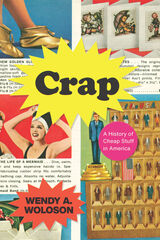 Crap: A History of Cheap Stuff in America
Wendy A. Woloson
University of Chicago Press, 2020 Crap. We all have it. Filling drawers. Overflowing bins and baskets. Proudly displayed or stuffed in boxes in basements and garages. Big and small. Metal, fabric, and a whole lot of plastic. So much crap. Abundant cheap stuff is about as American as it gets. And it turns out these seemingly unimportant consumer goods offer unique insights into ourselves—our values and our desires.
In Crap: A History of Cheap Stuff in America, Wendy A. Woloson takes seriously the history of objects that are often cynically-made and easy to dismiss: things not made to last; things we don't really need; things we often don't even really want. Woloson does not mock these ordinary, everyday possessions but seeks to understand them as a way to understand aspects of ourselves, socially, culturally, and economically: Why do we—as individuals and as a culture—possess these things? Where do they come from? Why do we want them? And what is the true cost of owning them?
Woloson tells the history of crap from the late eighteenth century up through today, exploring its many categories: gadgets, knickknacks, novelty goods, mass-produced collectibles, giftware, variety store merchandise. As Woloson shows, not all crap is crappy in the same way—bric-a-brac is crappy in a different way from, say, advertising giveaways, which are differently crappy from commemorative plates. Taking on the full brilliant and depressing array of crappy material goods, the book explores the overlooked corners of the American market and mindset, revealing the complexity of our relationship with commodity culture over time.
By studying crap rather than finely made material objects, Woloson shows us a new way to truly understand ourselves, our national character, and our collective psyche. For all its problems, and despite its disposability, our crap is us.
Crash
Abby Larson
Harvard University Press
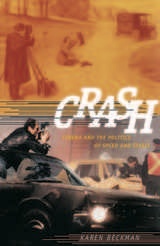 Crash: Cinema and the Politics of Speed and Stasis
Karen Beckman
Duke University Press, 2010 Artists, writers, and filmmakers from Andy Warhol and J. G. Ballard to Alejandro González Iñárritu and Ousmane Sembène have repeatedly used representations of immobilized and crashed cars to wrestle with the conundrums of modernity. In Crash, Karen Beckman argues that representations of the crash parallel the encounter of film with other media, and that these collisions between media offer useful ways to think about alterity, politics, and desire. Examining the significance of automobile collisions in film genres including the “cinema of attractions,” slapstick comedies, and industrial-safety movies, Beckman reveals how the car crash gives visual form to fantasies and anxieties regarding speed and stasis, risk and safety, immunity and contamination, and impermeability and penetration. Her reflections on the crash as the traumatic, uncertain moment of inertia that comes in the wake of speed and confidence challenge the tendency in cinema studies to privilege movement above film’s other qualities. Ultimately, Beckman suggests that film studies is a hybrid field that cannot apprehend its object of study without acknowledging the ways that cinema’s technology binds it to capitalism’s industrial systems and other media, technologies, and disciplines.
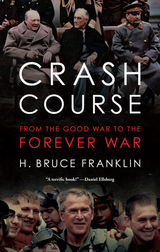 Crash Course: From the Good War to the Forever War
Franklin, H. Bruce
Rutgers University Press, 2024 Growing up during the Second World War, H. Bruce Franklin believed what he was told: that America’s victory would lead to a new era of world peace. Like most Americans, he was soon led to believe in a world-wide Communist conspiracy that menaced the United States, forcing the nation into a disastrous war in Korea. But once he joined the U.S. Air Force and began flying top-secret missions as a navigator and intelligence officer, what he learned was eye-opening. He saw that even as the U.S. preached about peace and freedom, it was engaging in an endless cycle of warfare, bringing devastation and oppression to fledgling democracies across the globe.
Now, after fifty years as a renowned cultural historian, Franklin offers a set of hard-learned lessons about modern American history. Crash Course is essential reading for anyone who wonders how America ended up where it is today: with a deeply divided and disillusioned populace, led by a dysfunctional government, and mired in unwinnable wars. It also finds startling parallels between America’s foreign military exploits and the equally brutal tactics used on the home front to crush organized labor, antiwar, and civil rights movements.
More than just a memoir or a history book, Crash Course gives readers a unique firsthand look at the building of the American empire and the damage it has wrought. Shocking and gripping as any thriller, it exposes the endless deception of the American public, and reveals from inside how and why many millions of Americans have been struggling for decades against our own government in a fight for peace and justice.
 Crash Cultures: Modernity, Mediation and the Material
Edited by Jane Arthurs and Iain Grant
Intellect Books, 1995 Since Diana's car crash in August 1997, media interest in the crash as an event needing explanation has proliferated. A glut of documentaries on television have investigated the social and scientific history of our responses to the car crash, as well as showing the personal impact of the crash on individual lives.
In trying to give meaning to one celebrity crash, the more general significance of the car crash, its challenge to rational control or explanation, its disregard for the subject and its will, became the focus for attention. Coincidentally, the two most newsworthy films of 1997 were David Cronenberg's Crash and James Cameron's Titanic, both of which generated intense popular interest.
The principal purpose of this collection of essays is to subject texts, within which crashes figure, to well-defined cultural study. The themes that emerge from this collection, which is truly experimental in attempting to draw together the resources for a cultural study of events, are many and varied. Moreover, they vary in format, in order to bring as many modes of address as possible to bear on the crashes that catastrophically and fantastically punctuate the fabric of everyday life.
 Crashing Thunder: The Autobiography of an American Indian
Paul Radin
University of Michigan Press, 1999 Paul Radin, one of America's first and most reputable professional anthropologists, lived among the Winnebago Indians for years, and for years he tried without success to interview the notorious younger son of the Blow Snake family, the Crashing Thunder of this book. At last Crashing Thunder agreed to tell Radin his life story, one that Radin calls "a true rake's progress."
Speaking through Radin, Crashing Thunder told of his childhood, stories of Winnebago gods, his appetite for women and beer, and his extraordinary friends and relatives, including his brother-in-law, Thunder Cloud, then in his third incarnation. Crashing Thunder also told of his redemption through his new religion, peyote.
To enhance understanding of the autobiography and its place in anthropology and literature, a new foreword, appendix, and index have been prepared by eminent Native American scholar, Arnold Krupat.
 Crash-Landing: A Novel
Peter Spielberg
University of Alabama Press, 1985 Crash-Landing is an exploration of modern day fear and failure. Its subject is self-delusion and self-fulfillment, sexual entanglements and midlife anxiety, marriage and existential loneliness. Named after Lindbergh, his parents' hero, Charles Burg has neither the requisite head for heights nor the stomach to go it alone. Though destined for a fall, he contrives—by never looking down—to keep his marriage to Anne aloft through years of circling, of buffeting crosswinds, instrument failure and near collisions. When the crackup finally comes, the touchdown is not tragic, flaming wreck, but a nose-in-the-mud return to ground zero.
Both survive the forced landing. Anne comes through better: she manages to walk away from the wreckage. Chuck crawls off, emotionally grounded. We last see him fleeing across the Atlantic, winging toward an eighty-day crash cure at a rehabilitation camp fpr bereaved ex-husbands "some twenty kilometers south of Breat."
Or rather, that is the reader's first glimpse of this comedy's anti-hero, for events unfold in reverse order appearance - from the crackup back to the passionate beginning that led to the marriage. The story's counter-chronological movement gives the reader foresight, while Chuck, its first-person narrator, remains, happily or ironically, unaware of the laws of physics that govern the all too short duration of love's flight.
|
|

